Warcraft Retrospective 21: A Boy, a Girl, and a Grandpa
While the orcs and their new troll allies are sailing to Kalimdor, we turn to the human campaign. It’s titled “The Scourge of Lordaeron”. Ominous.
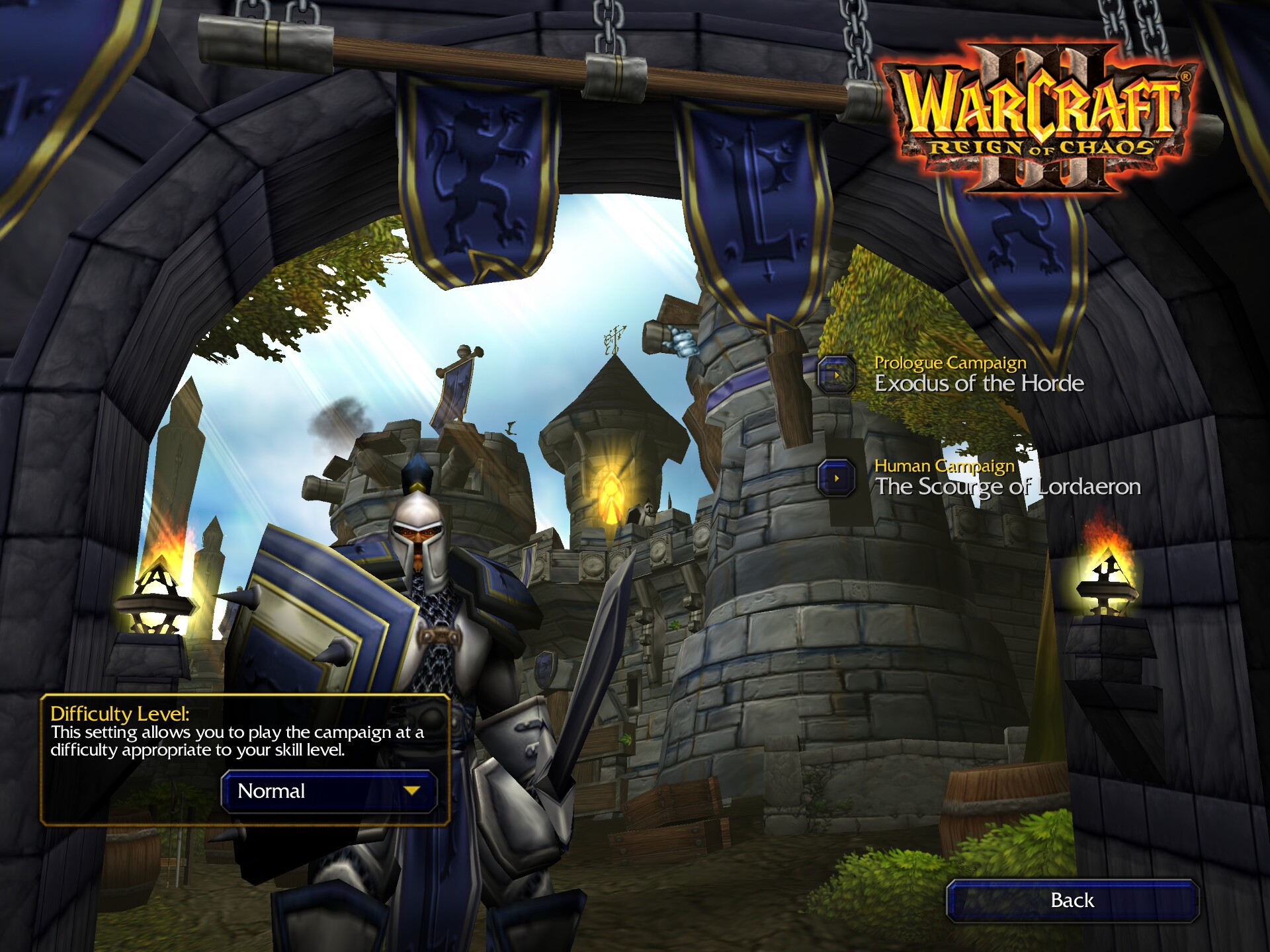
Before we meet the actual protagonists of the campaign, however, we’ll have to go through the…
Intro Cinematic
This was actually the first campaign cinematic I saw back in 2002, since I began the human campaign before the prologue one. After all, as I reasoned back then, orcs are bad guys and humans are good guys, so I should start with the humans!
Here, the raven, who we already know is the Prophet, flies past snowy peaks and a desert into the capital city of Lordaeron, a beautiful city of spires on a lake.1 I remember being amazed by the level detail back then, and even today this cinematic has aged well, blurriness aside.
King Terenas of Lordaeron, on his throne, is convening with representatives of the Alliance. He’s a tired old man with strong opinions. The orcs are on the move again, but the Dalaran ambassador believes they’re not the real threat — the mysterious plague spreading through the northlands is. He wants the villages to be put in quarantine, but Terenas believes the people of Lordaeron have already suffered enough.
Suddenly, the Prophet:
- flies in;
- says humanity is in peril;
- demands that everyone abandons their homes and travels west to Kalimdor;
- refuses to elaborate further;
- leaves.
Gee, I wonder why nobody listened to him. If he’s really trying to save the world, he’s doing an awful job at being persuasive.
The Defense of Strahnbrad
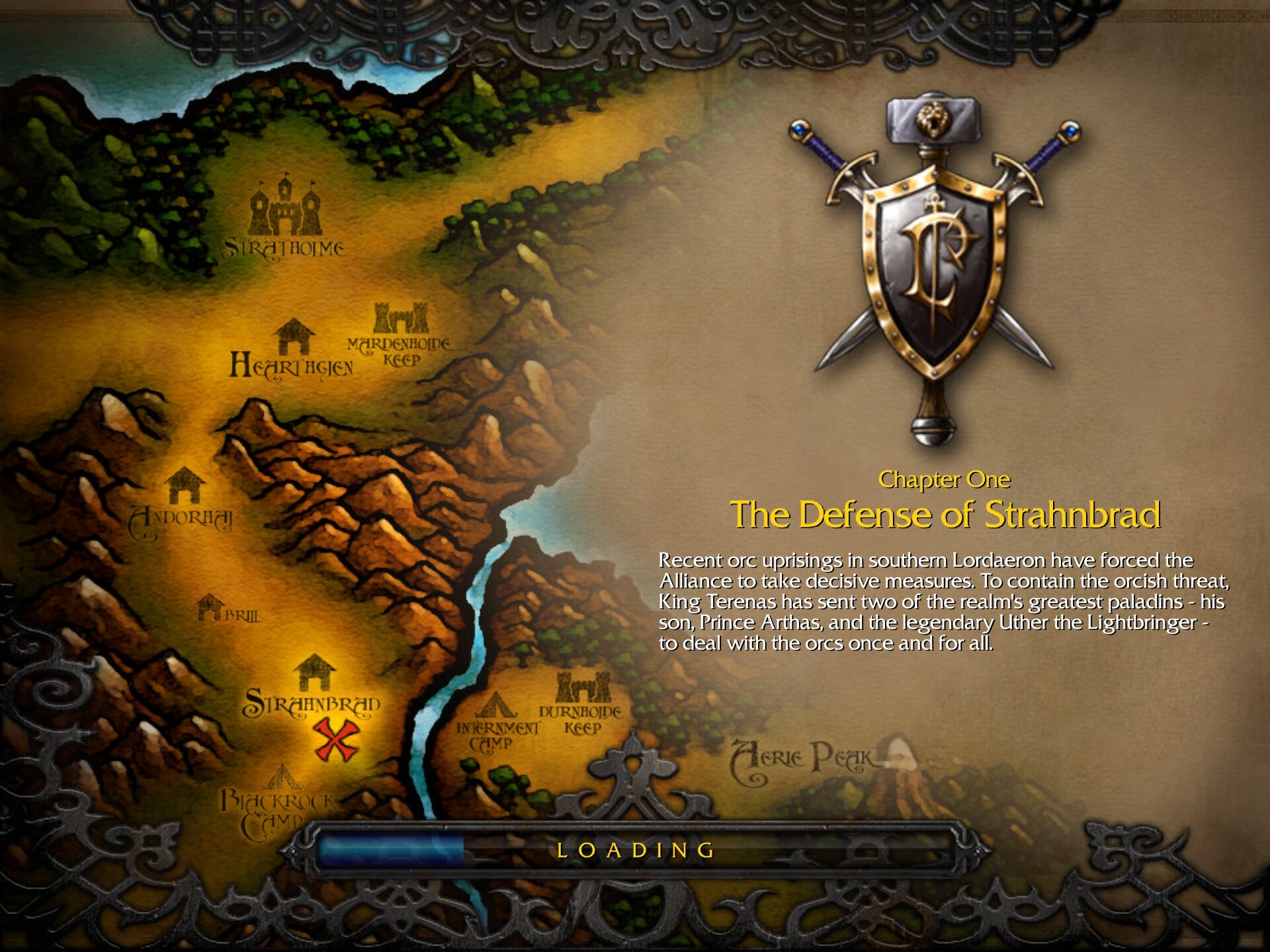
The human campaign is interesting in its approach to storytelling, in that it does something really clever.2 It sets up characters who embody very familiar and common fantasy archetypes, then gradually starts subverting these archetypes, and finally, smashes the entire setup to pieces.
The campaign revolves around the personalities of Arthas, Uther and Jaina, and the friction between them. I’ll talk about Jaina a bit later — for now, let’s focus on the other two.
Arthas, the prince of Lordaeron, is King Terenas’s son. He’s very much hero-coded: a handsome blonde man, the heir to the throne, and a knight in proverbial shining armor.3 Uther the Lightbringer4 is an old seasoned paladin, a veteran of the Second War who, according to the manual, is 64 years old at the time of Warcraft 3. He’s our old wise mentor figure.
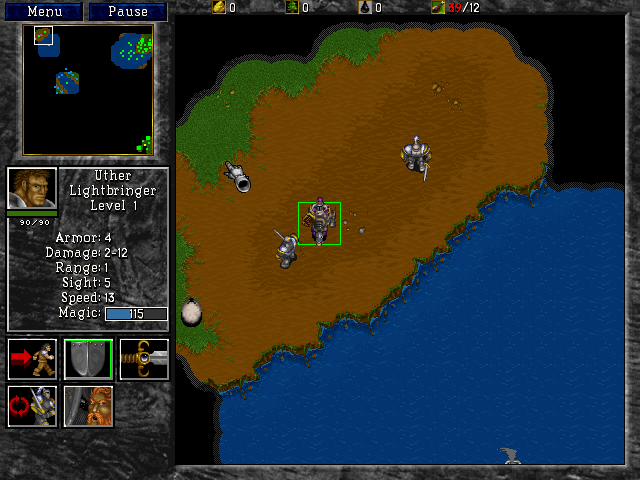
And, of course, Arthas’s name is evocative of the legendary King Arthur, while Uther is named after Uther Pendragon, King Arthur’s father.
We begin with a cutscene where Arthas arrives at the camp where Uther is training some footmen.
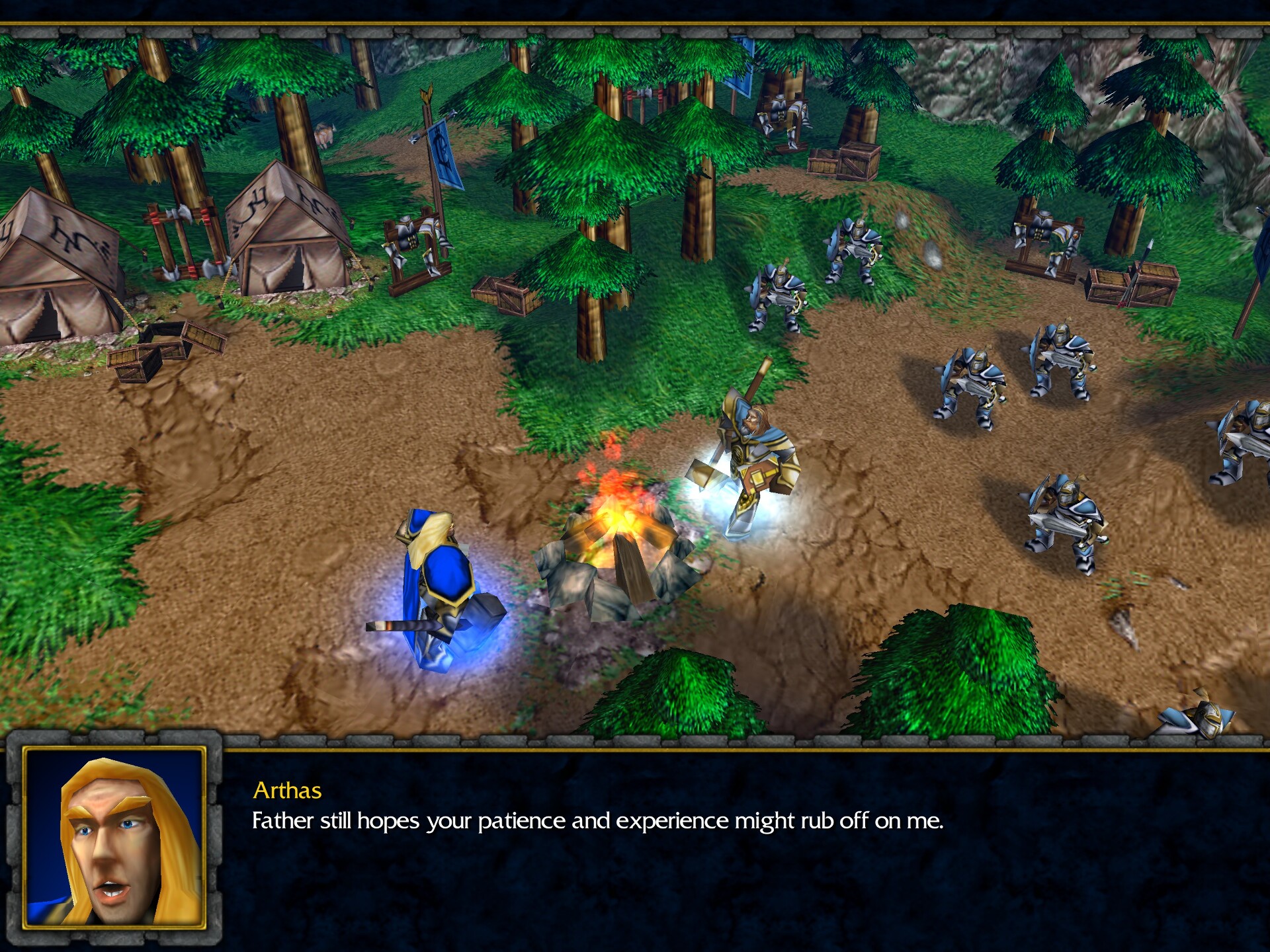
Short as it is, their conversation establishes a few important things:
- They’re on cordial terms and have a history together.
- Arthas is not above laughing at his own expense.
- Arthas has much to learn, in terms of both experience and patience.
- Uther cares about Arthas, as a benevolent mentor would.
It turns out there’s an orc encampment nearby, and they’re preparing to attack the nearby human village of Strahnbrad. Uther decides to move out against the encampment, so the defense of Strahnbrad falls to Arthas (and the few footmen around). We get control of our hero, and the cutscene ends.
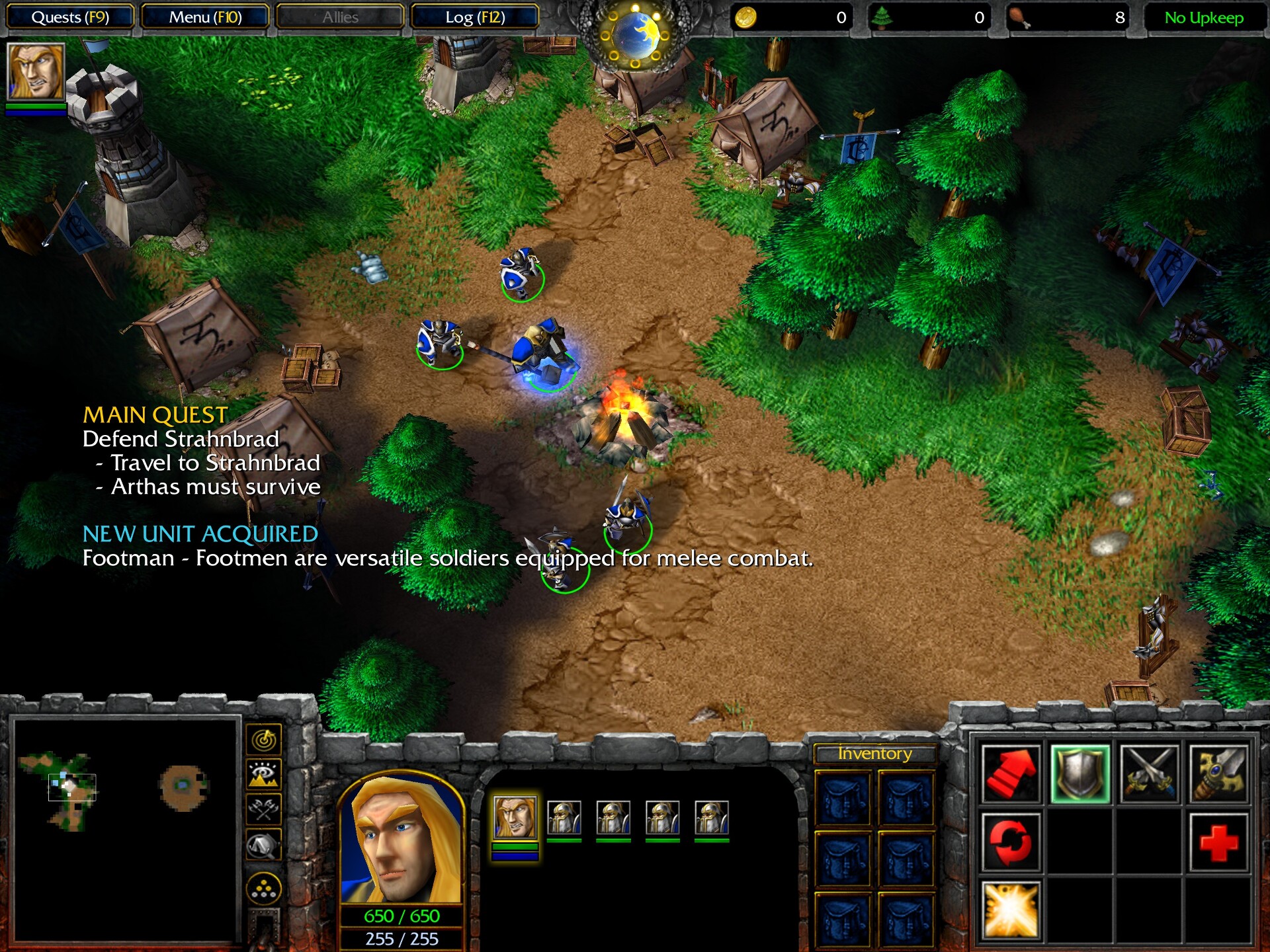
This mission acts as another tutorial — a less handholdy one than the first prologue mission. You stroll through the pastoral countryside of Lordaeron. You can just follow the road, but if you take the unpaved path south (which I admit I completely missed on my first four or so playthroughs), you’ll arrive in a village and will be greeted by its residents. Everything seems peaceful.
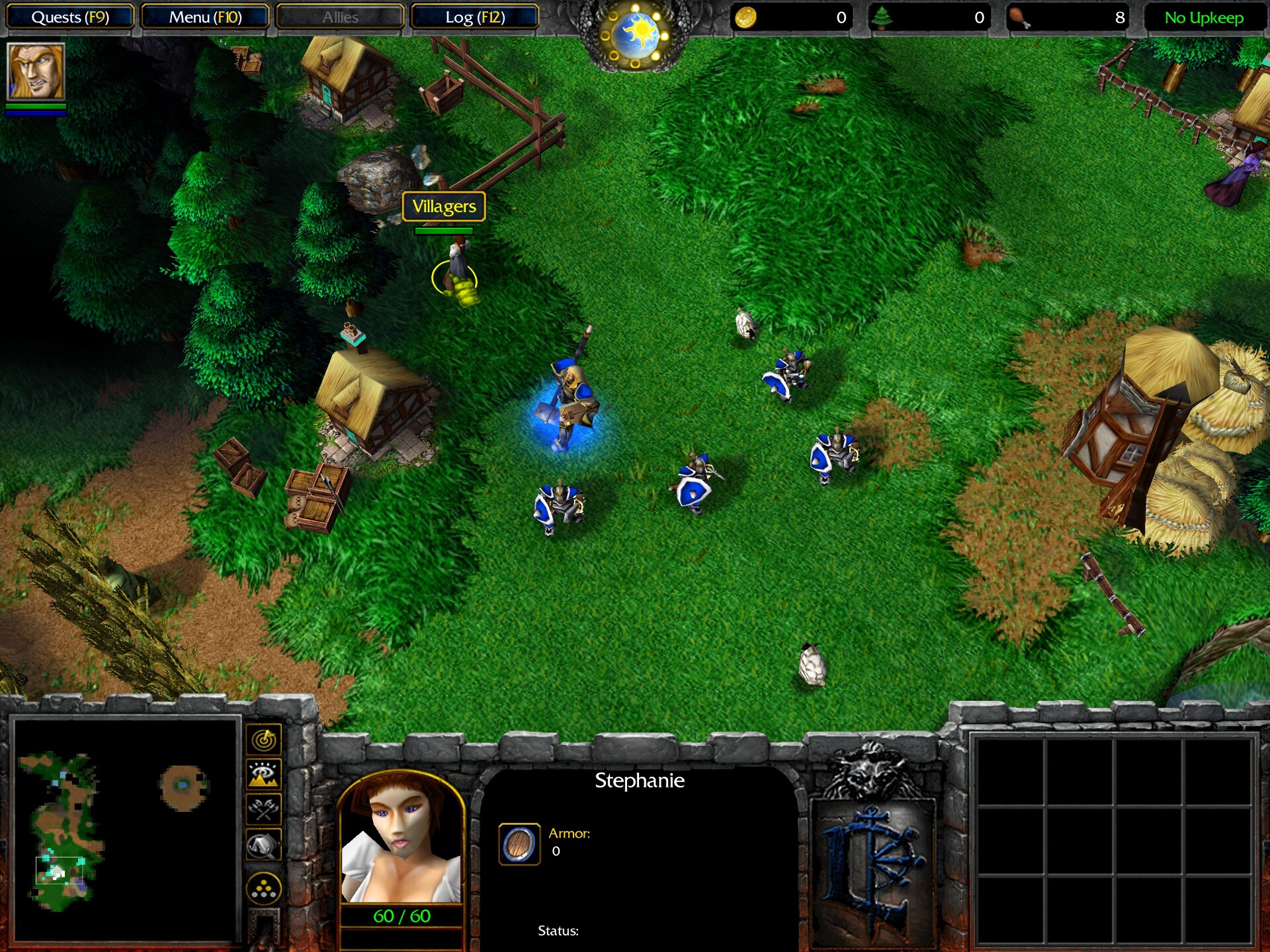
Speaking of villagers, something seems to be amiss with the names. So far, human names in Warcraft 1, 2, and the novels had a definite fantasy “land far far away” feel to them: Khadgar, Medivh, Aegwynn, Terenas, Rhonin. However, here in Warcraft 3, Lordaeronian commoners have very much normal European names like Stephanie, Ryan, Alicia, and Timmy.5 This ends up creating a weird Aerith and Bob effect when the two naming conventions meet.
And the village is worth exploring, as there’s good stuff here. For example, these two villagers will turn into footmen when approached.
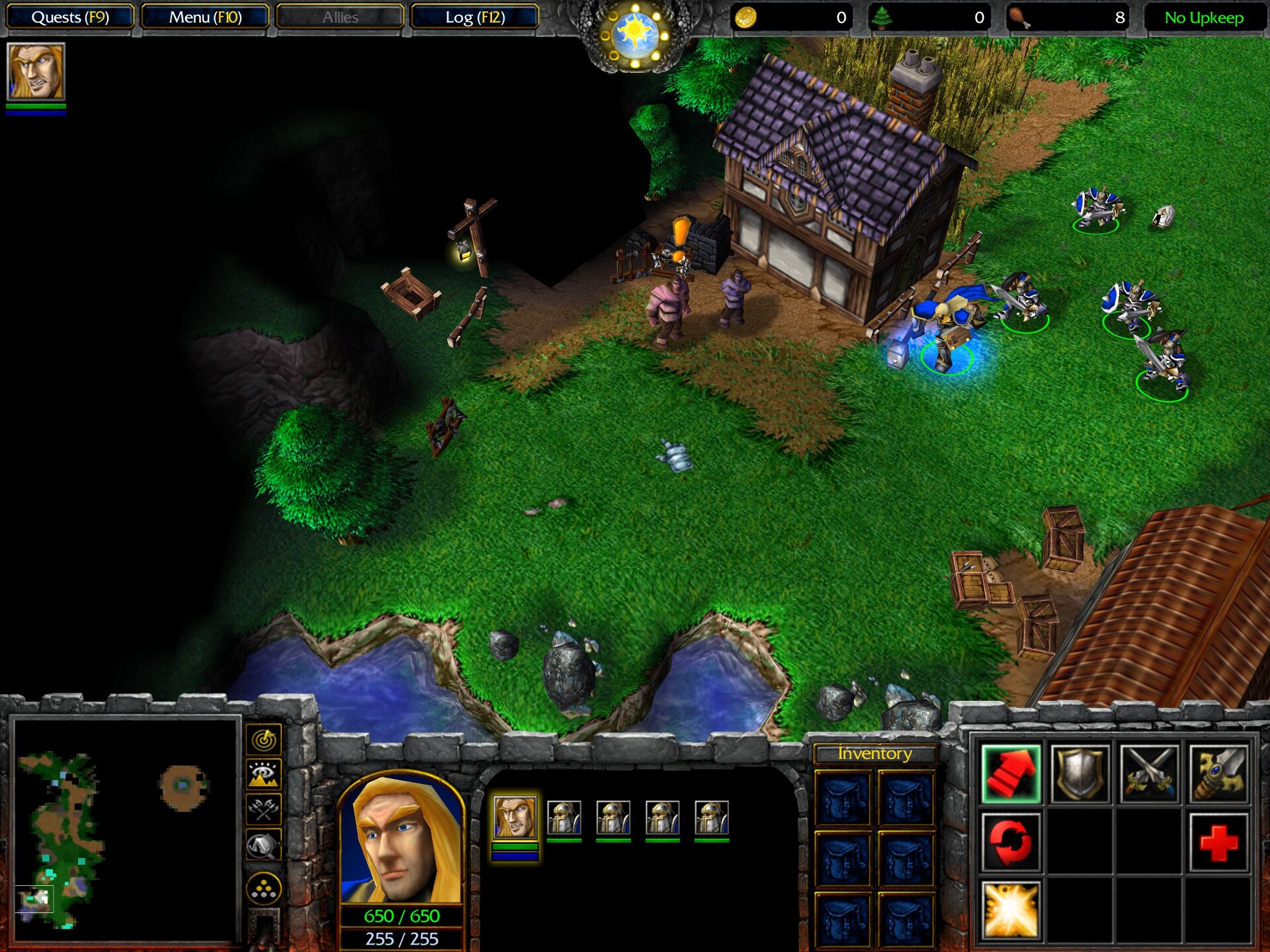
We also get our first real side quest here. A woman named Alicia wants us to save her little son, Timmy, from gnoll kidnappers. As a reward, we get a Ring of Protection +1.
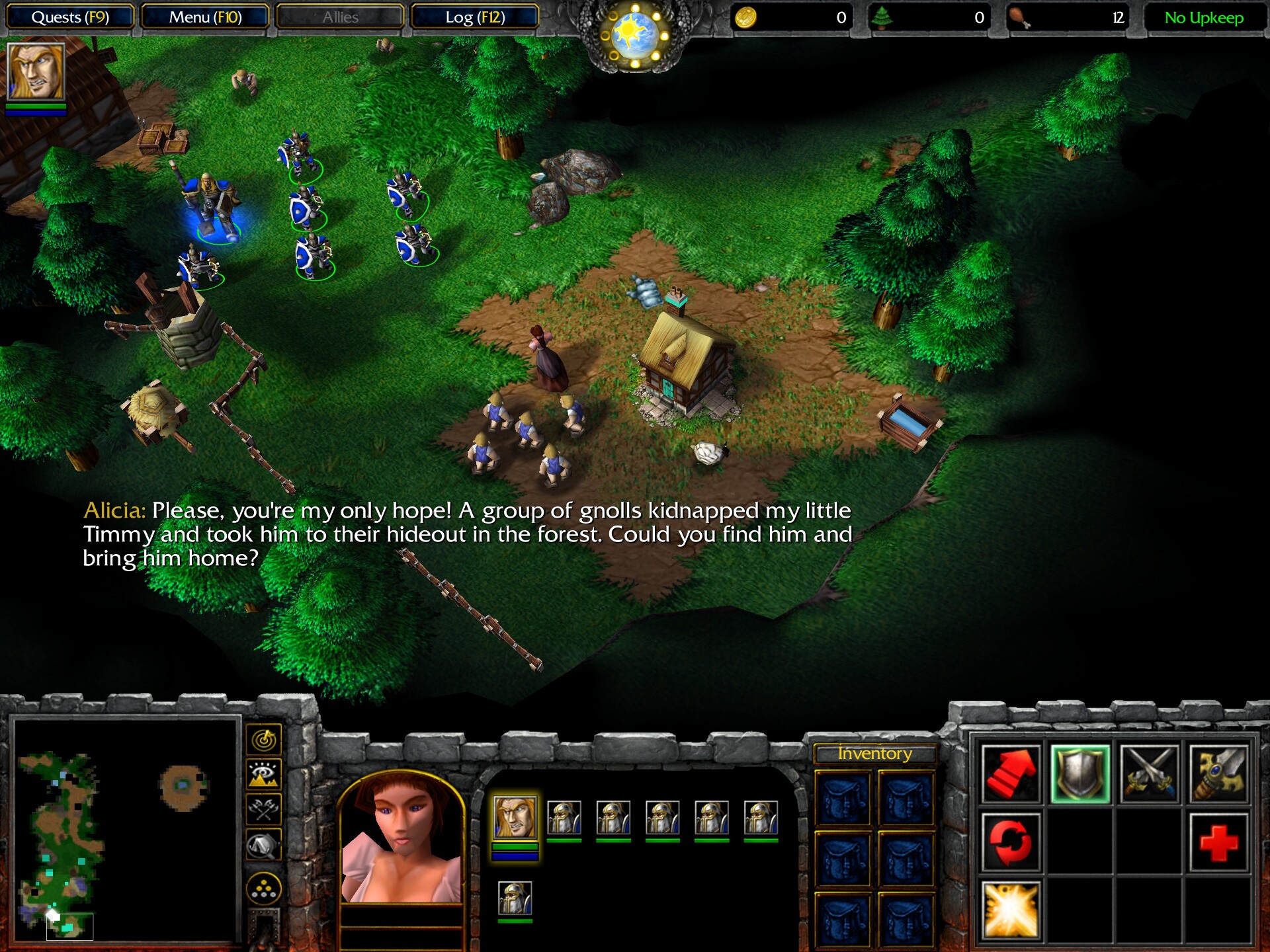
I have to say this: child models in the original Warcraft 3 are really, really ugly. I understand that the developers had to be very scarce with polygons so that the game would run even on less powerful computers, so I’ll excuse things like Arthas’s hair looking like an angular yellow lump. But children only appear in the campaign, so there really was no reason to make their models this unnaturally stretched.
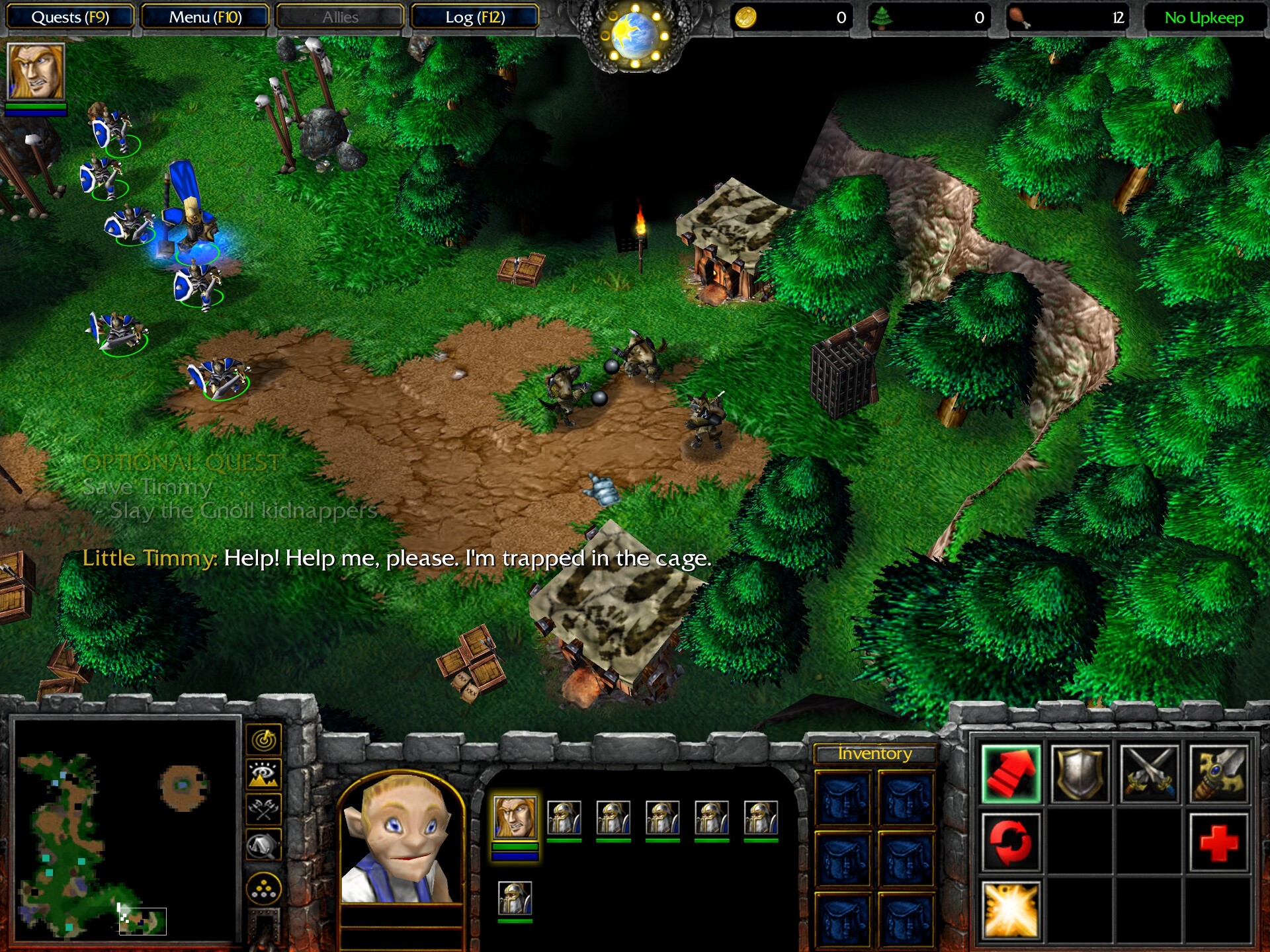
As a paladin, Arthas starts with the Holy Light spell, which does massive healing to a single unit, but has a long cooldown. If you time it right, you can complete this mission without losing a single unit.
There are more secrets here. There are some other villagers with an exclamation mark in the woods, but it’s a trap: they turn into bandits when approached.
And just in case you missed the Timmy quest, here we have another opportunity to learn how side quests work. A villager named Gerard has his ledger stolen by bandits, and without it he’ll lose his farm. There’s no way you can miss him, since he stands right by the bridge you have to cross to get to Strahnbrad. When we defeat the bandits and return to him, he rewards us with a Tome of Strength, which is automatically learned.
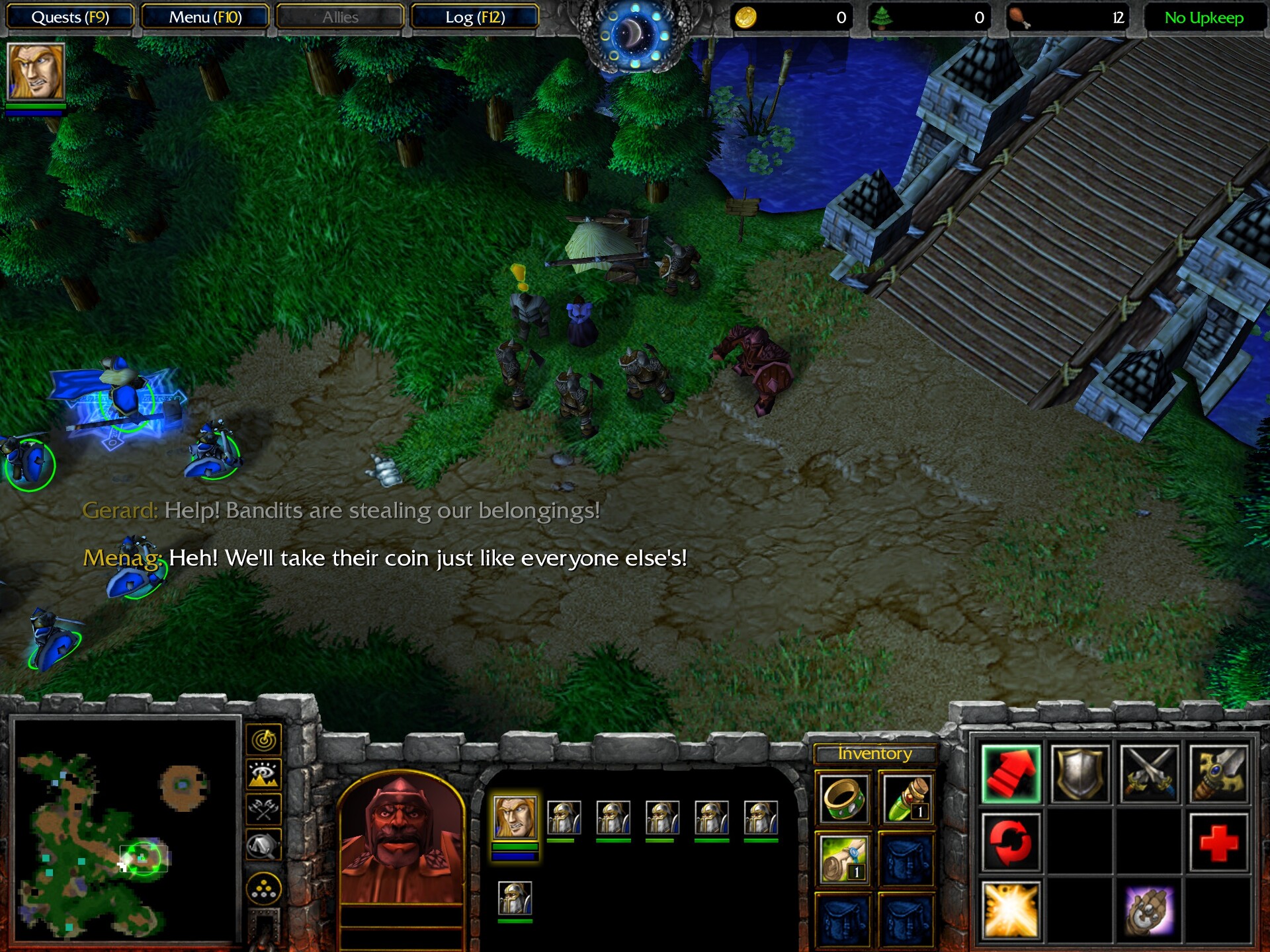
When we get to Strahnbrad itself, it’s already under attack by orcs of the Blackrock clan. It’s also worth exploring, since side paths give you yet more beneficial things — like these extra footmen who join you after you fend off the grunts they’re fighting.
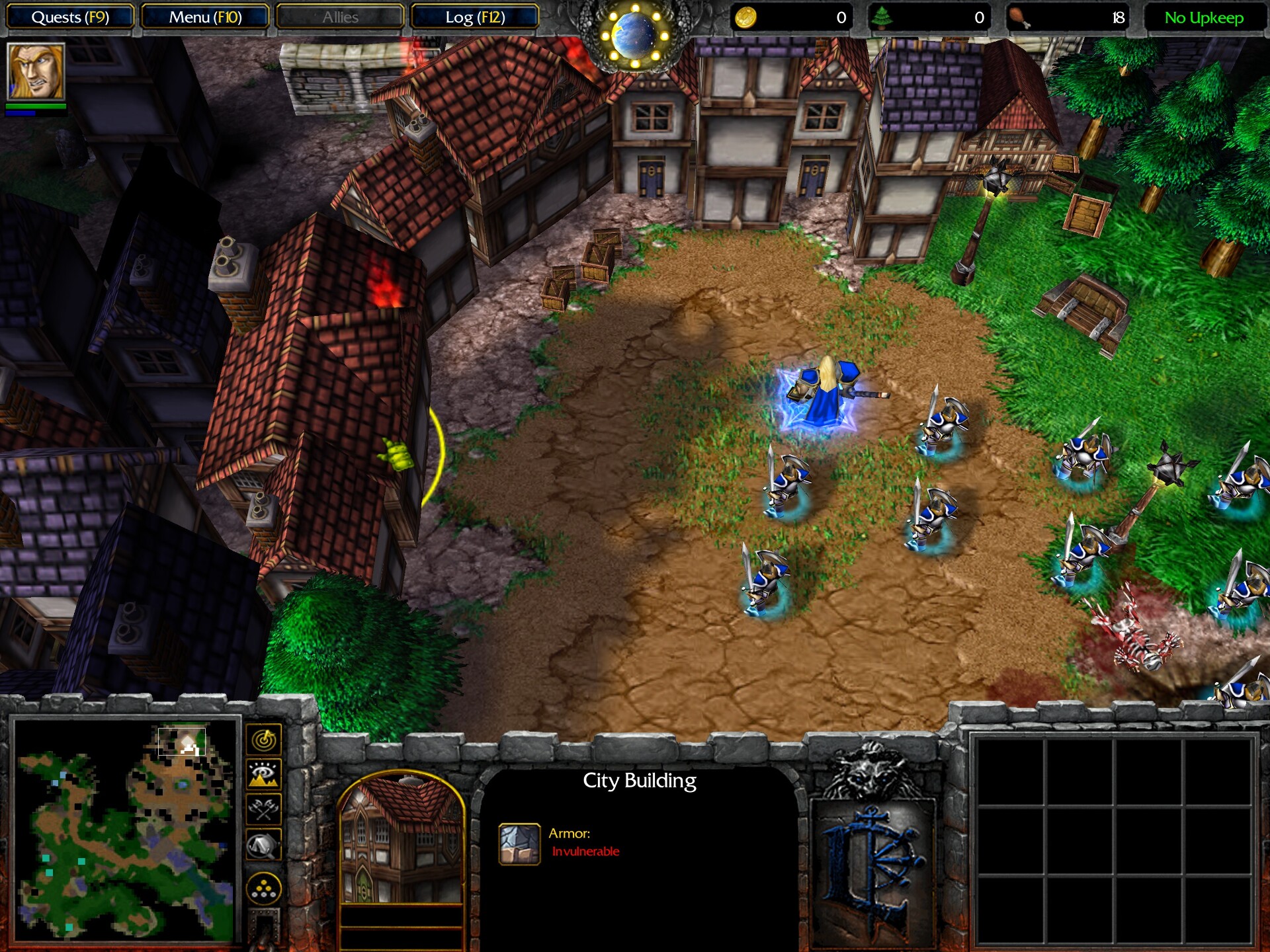
Unfortunately, you’re too late to save all the villagers. The orcs carry some of them off, and judging by the piles of bones, some villagers were even less lucky than that.
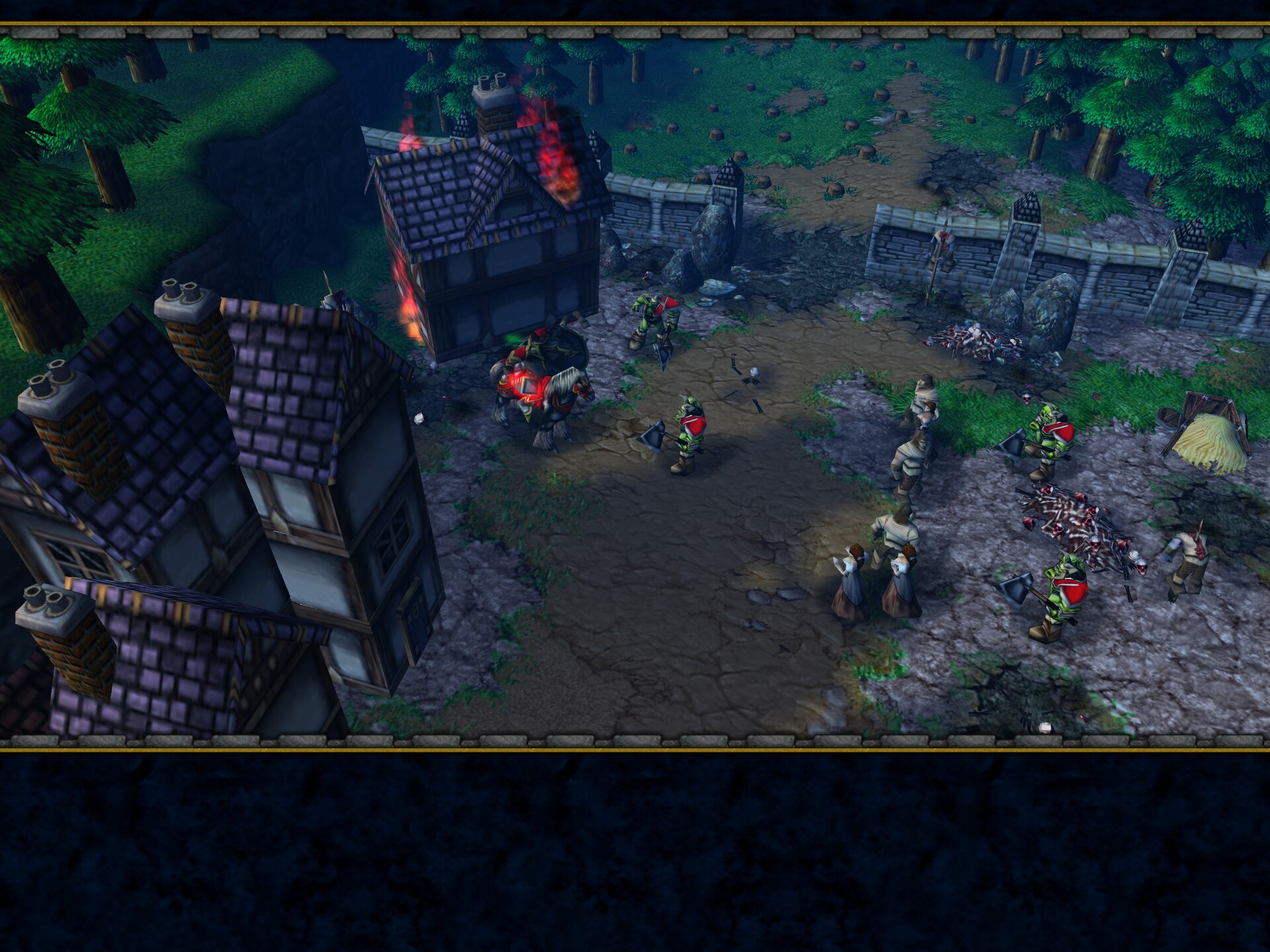
Here we get the first hint that these orcs aren’t from Thrall’s Horde: their leader is called the Slave Master, whereas Thrall despises slavery. Though the humans don’t know this yet, Thrall’s Horde has already sailed away and they’re facing completely different free orcs here. Another hint is that the Slave Master’s face is red, not green like for regular orcs!
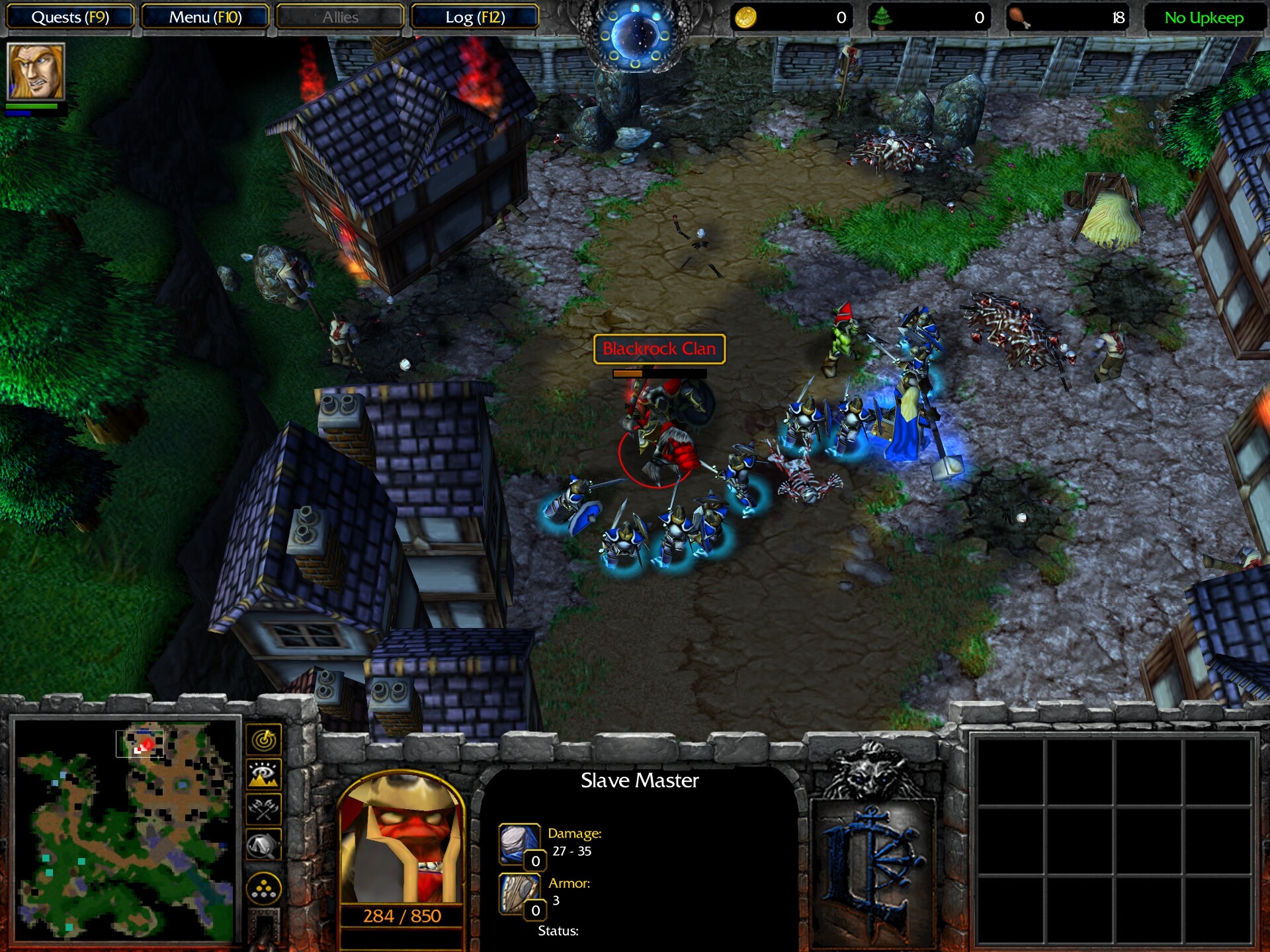
The Slave Master himself is a regular unit, and even with two grunts he’s no match for your army. When we defeat him, the villagers thank Arthas, and he promises to rescue everyone who’s been taken away… but before he can catch his breath, a knight arrives and requests his presence at Uther’s camp.
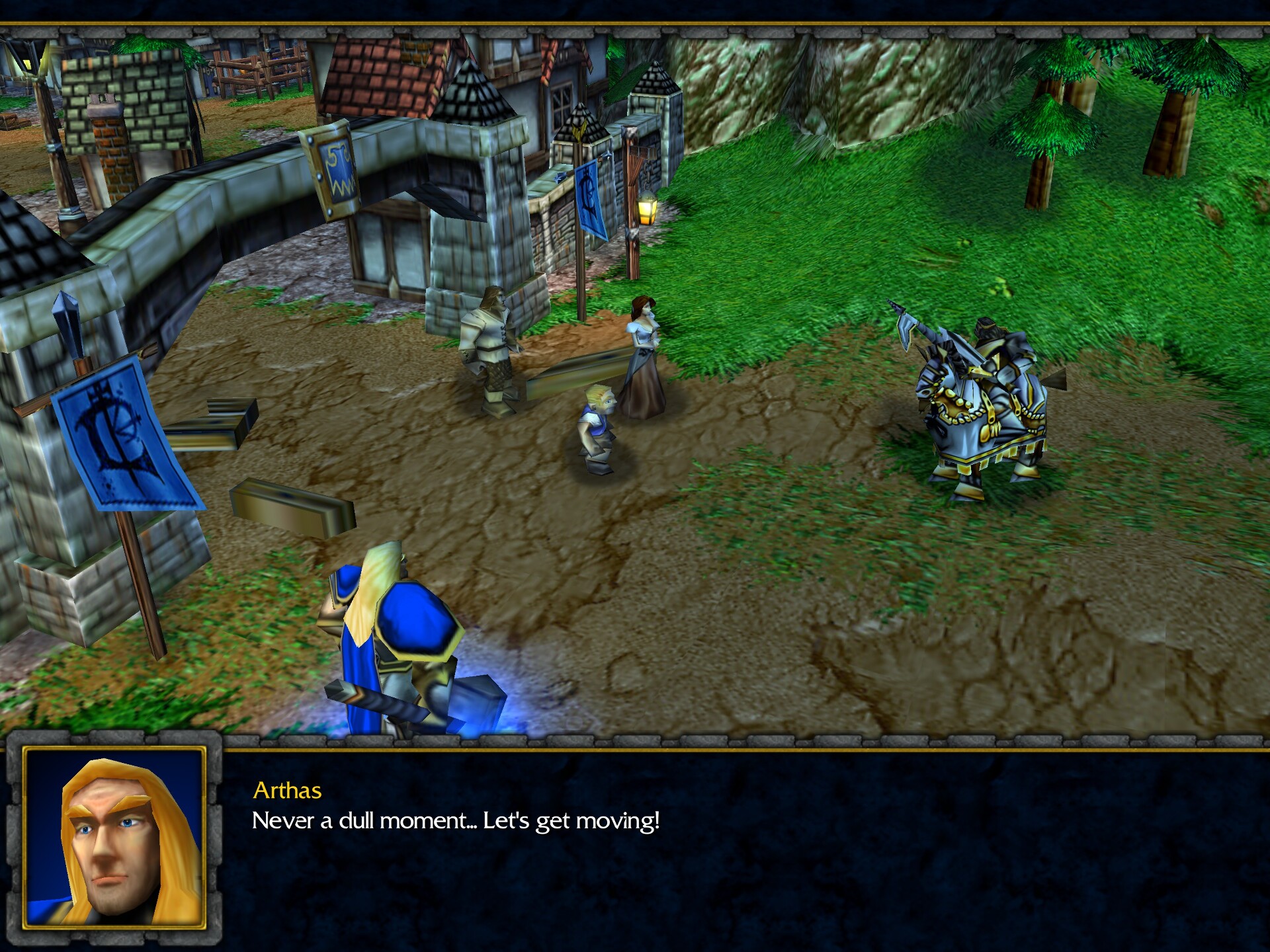
This mission has an upbeat tone to it. It shows Arthas at his best: as a kind-hearted paladin-prince, one who’s eager to protect his people and knows his way with both his hammer and words of reassurance. Terenas is not long for this world; he’s venerable and spends important meetings half-asleep on his throne. Soon, Arthas could have succeeded him and become a beloved king… if only fate had turned out differently.
Then again, perhaps not. Would Light Yagami have remained a decent person if he had never found the Death Note? We might not know, but we do know that the flaws that were amplified by his possession of the Death Note were there with him from the start.
Blackrock and Roll
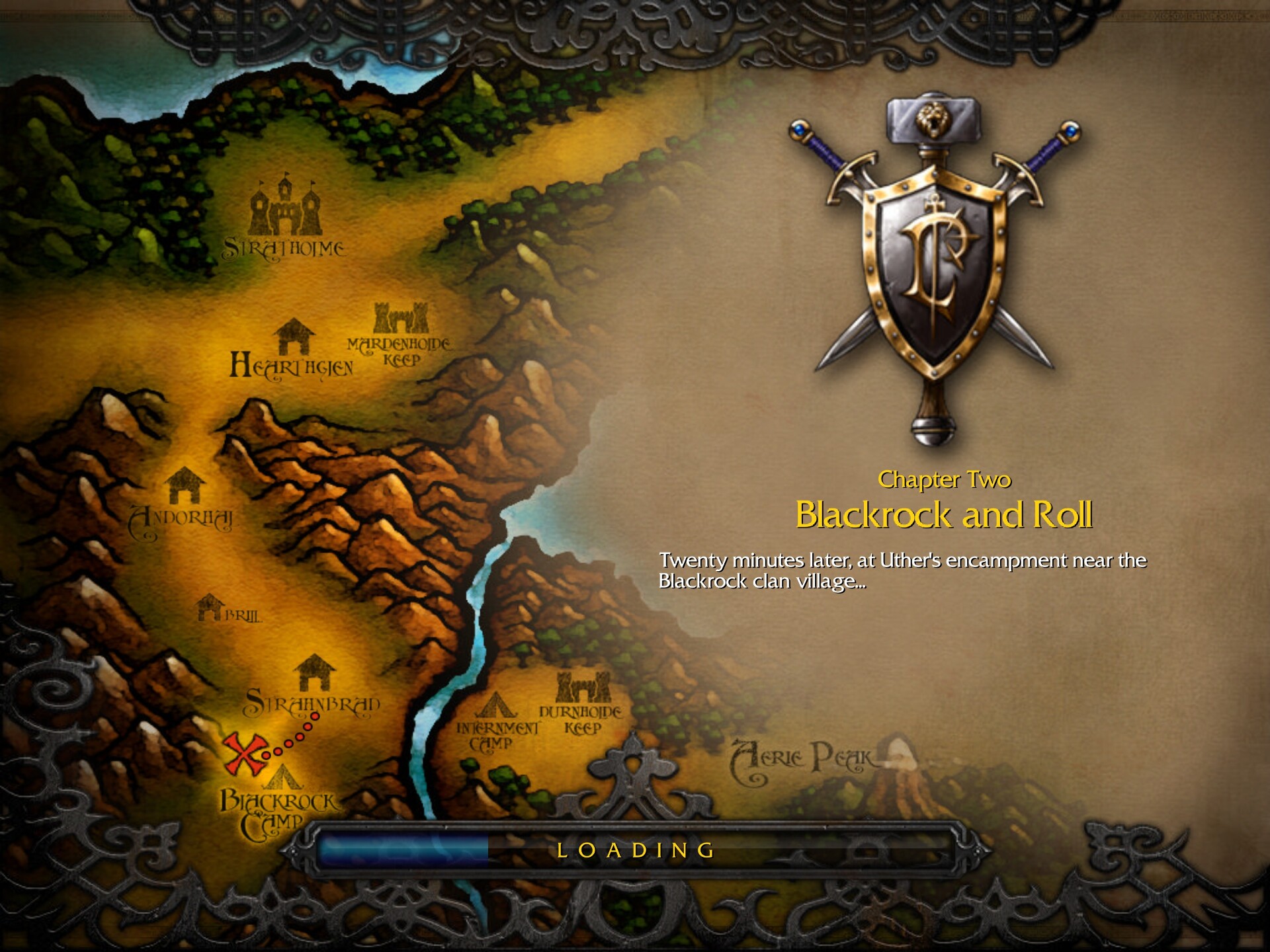
Arthas arrives at Uther’s camp and learns that Uther has sent two of his best knights to negotiate with the orc leader. However, only their horses return.
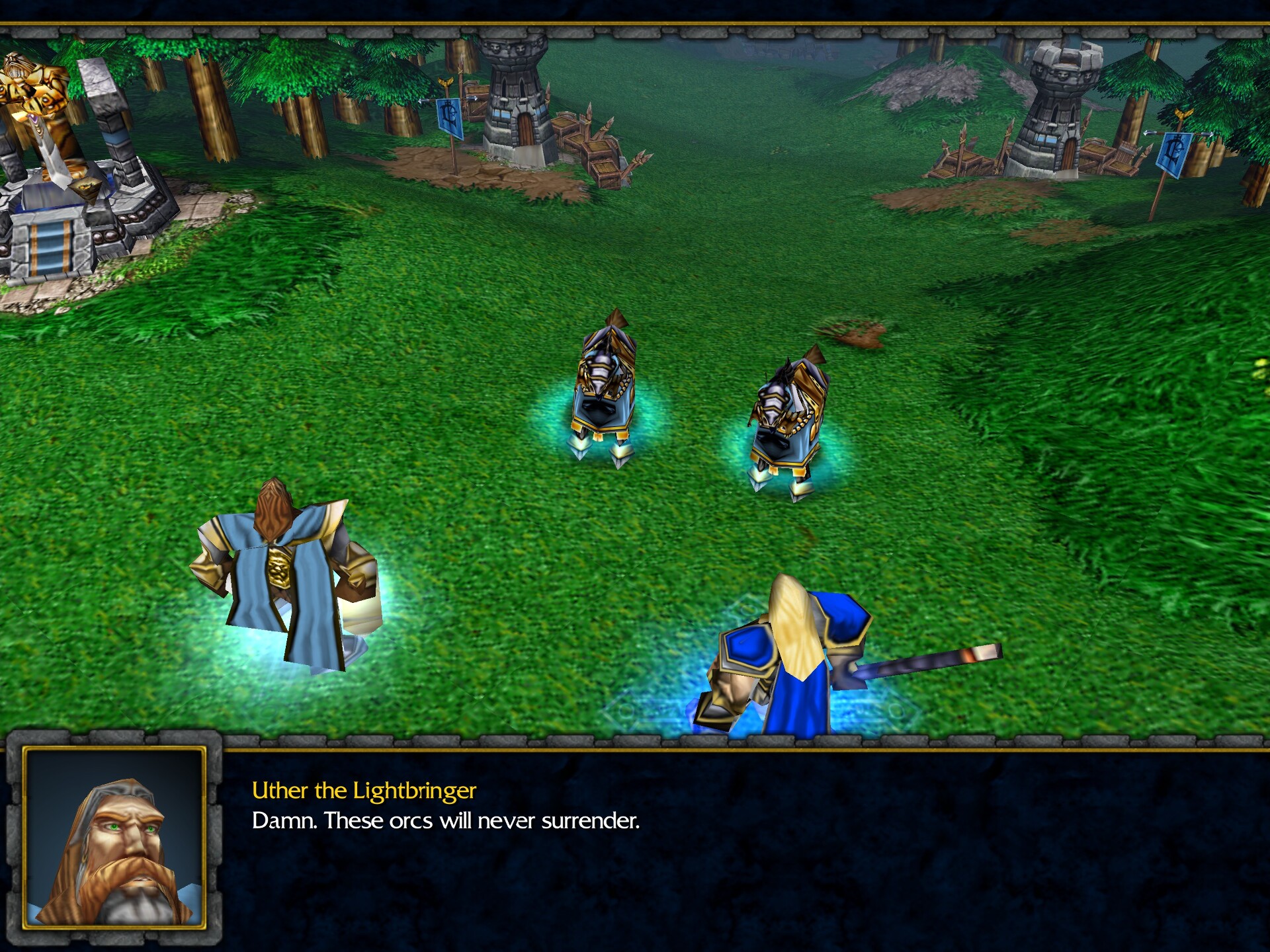
Yes, whoever the orc leader is, it’s certainly not Thrall.
Arthas is eager to retaliate, but Uther reminds him of the dangers of such overeagerness. Kind of. Paraphrased:
Arthas: Then let’s get in there and destroy the beasts!
Uther: Remember, Arthas, we are paladins. Vengeance cannot be a part of what we must do. If we allow our passions to turn to bloodlust, then we will become as vile as the orcs.
Arthas: Yes, Uther.
Uther: Now, get in there and destroy the beasts!
I don’t know if it’s supposed to be a character flaw — Uther is certainly not perfect — but the fact is, he’s encouraging his student, who has just demonstrated his rashness, to do exactly the thing Uther warned him to be cautious about.
We get the base under our control, and since this is a tutorial mission, our first task is to build it up. We build some farms, a barracks, and start training footmen. Meanwhile, Arthas is free to explore. Uther remains to defend the base, and as a level 10 paladin, he’s a one-man army. His AI is pretty good too — he pops Divine Shield when it makes sense and heals your wounded units. I suppose the mission designers didn’t want you to feel punished for exploration this early into the campaign, when you may have trouble multitasking between your field units and your base.
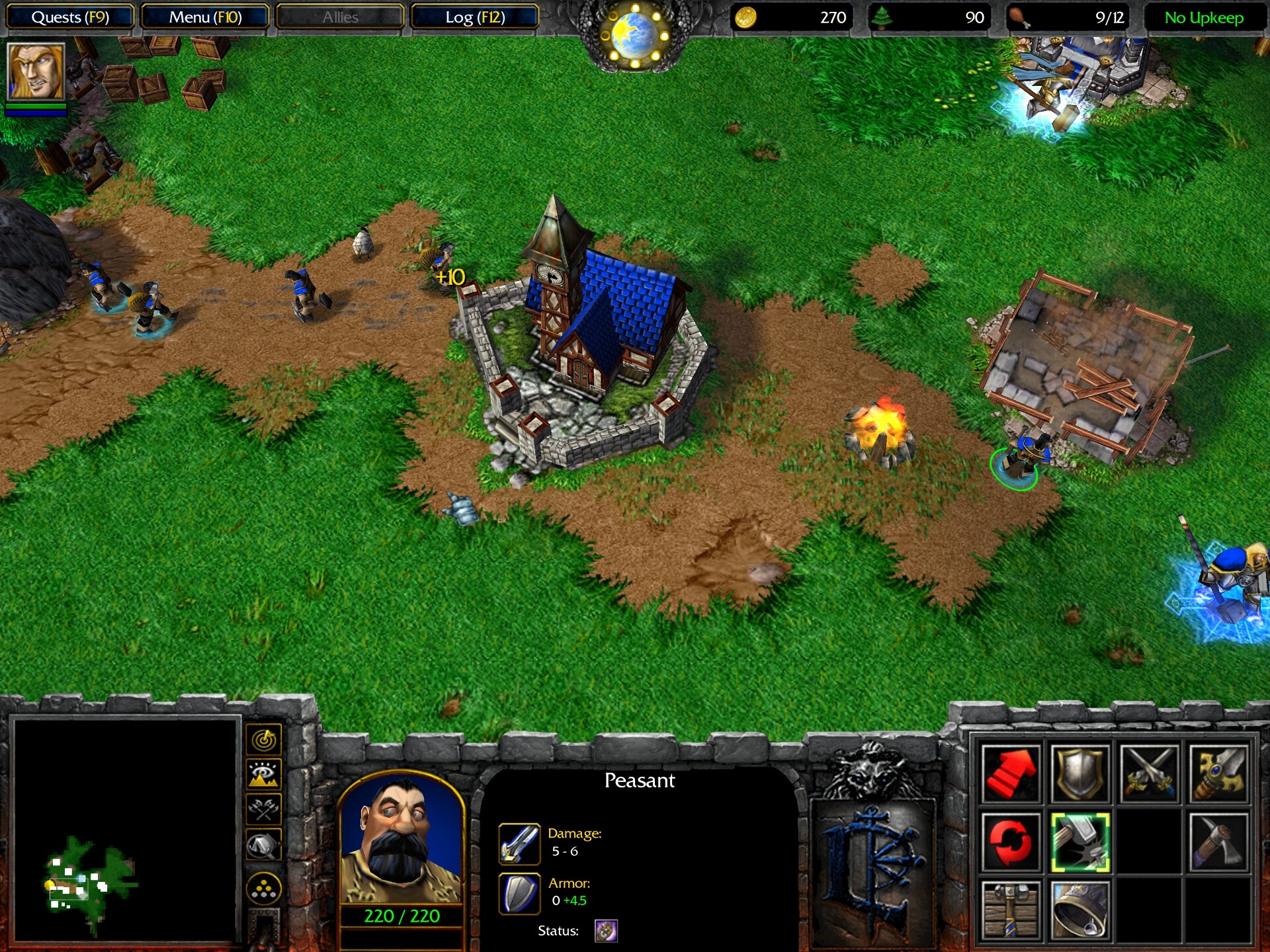
In Warcraft 3, every faction’s workers have some kind of shtick. Orc peons disappear inside buildings while constructing them, and can hide in burrows to shoot invaders like towers would. Human peasants, on the other hand, remain outside buildings during construction, and you can speed up construction by assigning extra peasants, spending resources over time as if for repair. In a crunch, peasants can also rally to the town hall and temporarily turn into militia, weak melee units.
Just outside his base, Arthas encounters some dwarves.
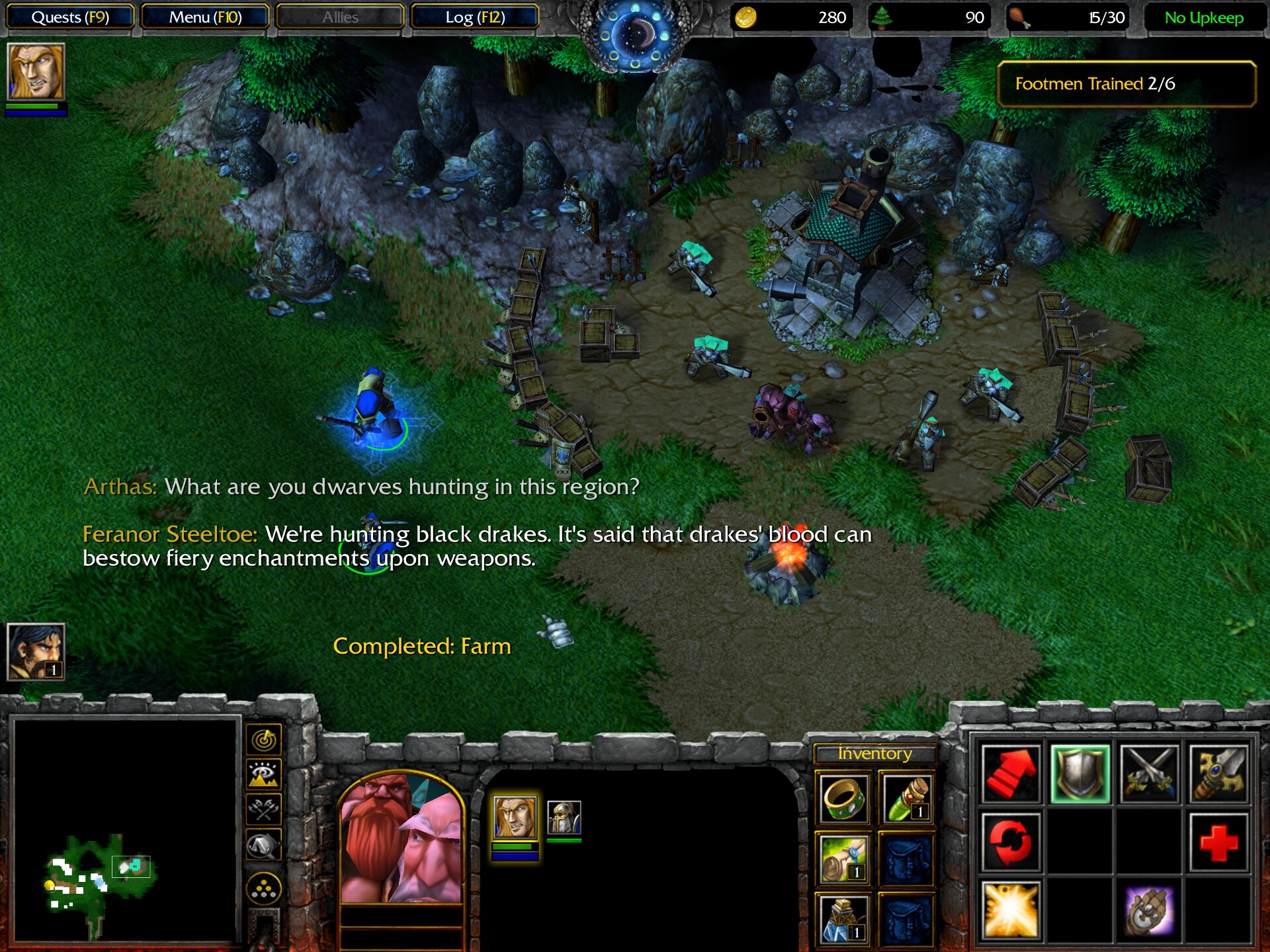
Their leader, Feranor Steeltoe, wants the heart of a black drake called Searinox. The four riflemen around him join your side, and you get a free blacksmith building where you can research upgrades. You also unlock the ability to train riflemen at your barracks. Searinox is found in a nearby winding cave, where your footmen are mostly useless, as you’ll be mostly fighting drakes and eventually Searinox himself. In return for his heart, Feranor makes Arthas an Orb of Fire, giving him bonus damage and making his attacks ranged against flying units. That would have been useful on this sidequest. Ah well.
After you train your sixth footman and complete the main quest, the Blademaster of the Blackrock clan comes to taunt Uther.
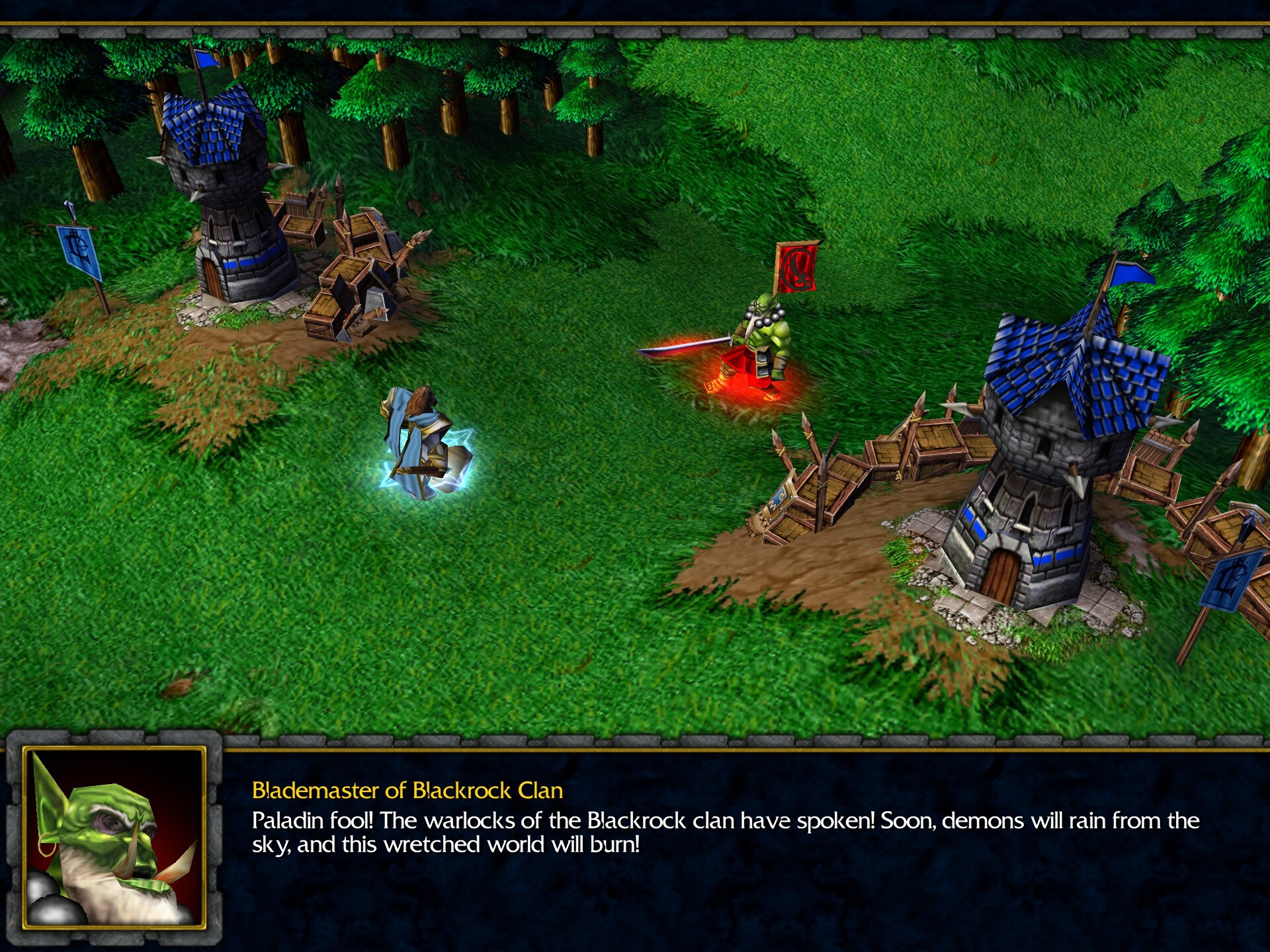
Uther attacks, but this was only a mirror image. The real Blademaster, meanwhile, proceeds with human sacrifices at his pit.
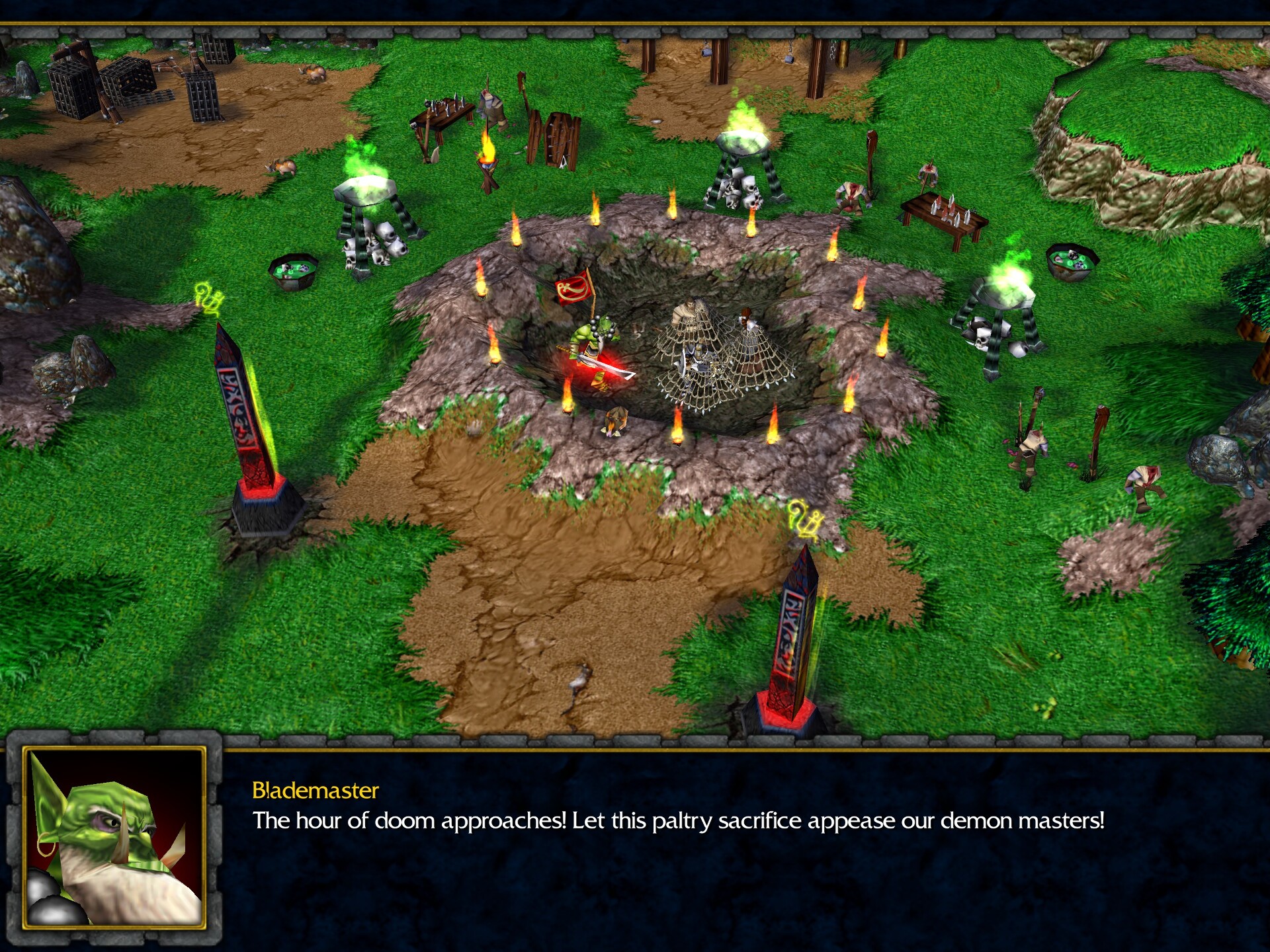
We’re not under time pressure, so we can explore the rest of the map. The orcs who attack our base actually have a base of their own, but it’s not the mission objective to destroy it (even though we can). I just hunted the creeps around the map and went straight for the Blademaster. As only a level 2 hero, he dies easily.
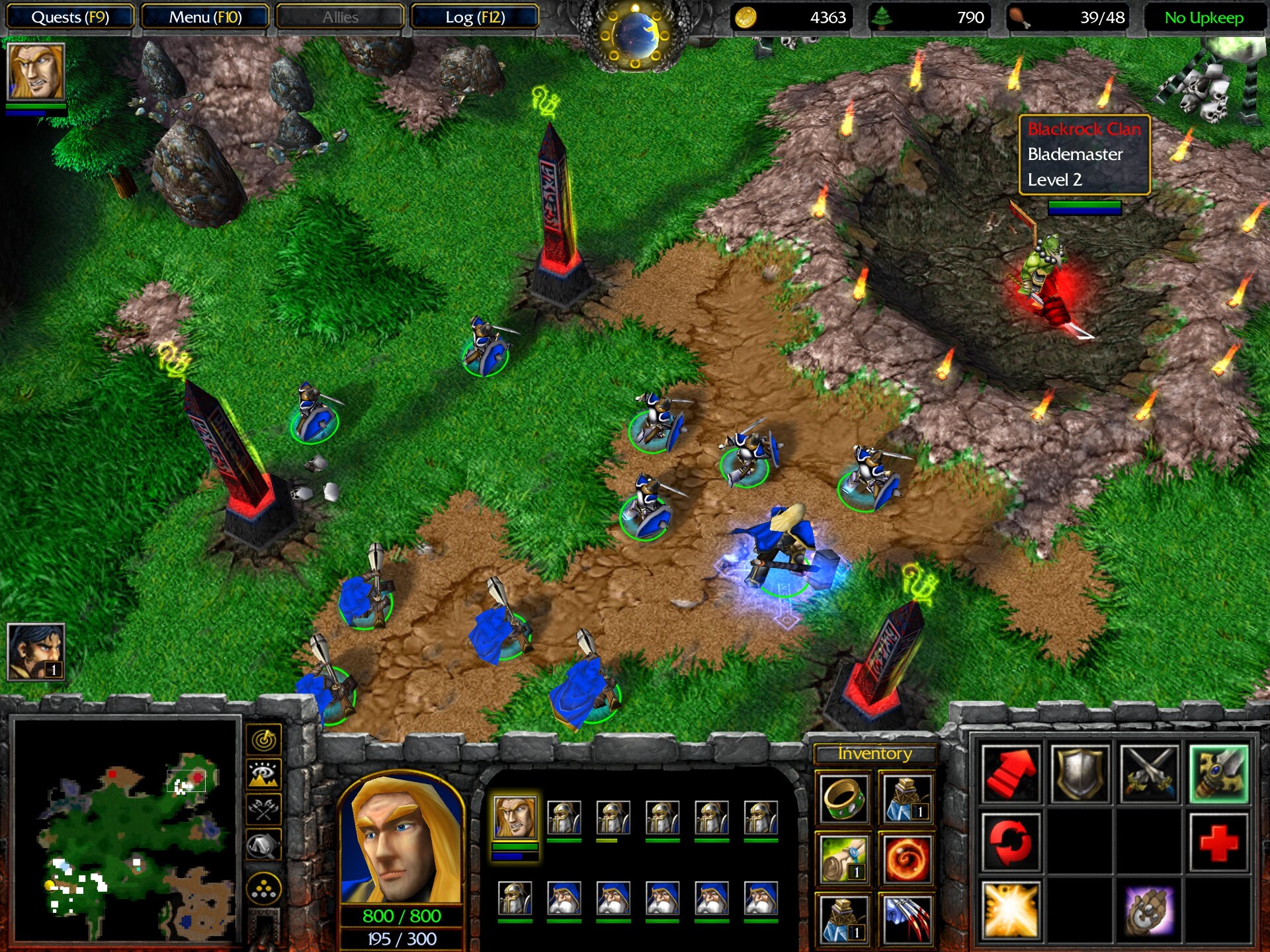
The day is saved, though Arthas has his doubts — the orcs were trying to summon demons, after all. But Uther assures him that the demons have been defeated long ago. Now the two can have some rest.
Ravages of the Plague
So now we can start our third mission — wait, what’s that?

That’s called an interlude — a long cutscene between missions. Warcraft 3 uses them as breaks between acts of a campaign, often focusing on what’s going on elsewhere, away from where the protagonists currently are. Here, for the first time, we see the mage city of Dalaran on screen.
The Prophet has brought his warnings of doom to Archmage Antonidas, leader of the Kirin Tor, who’s having none of it.
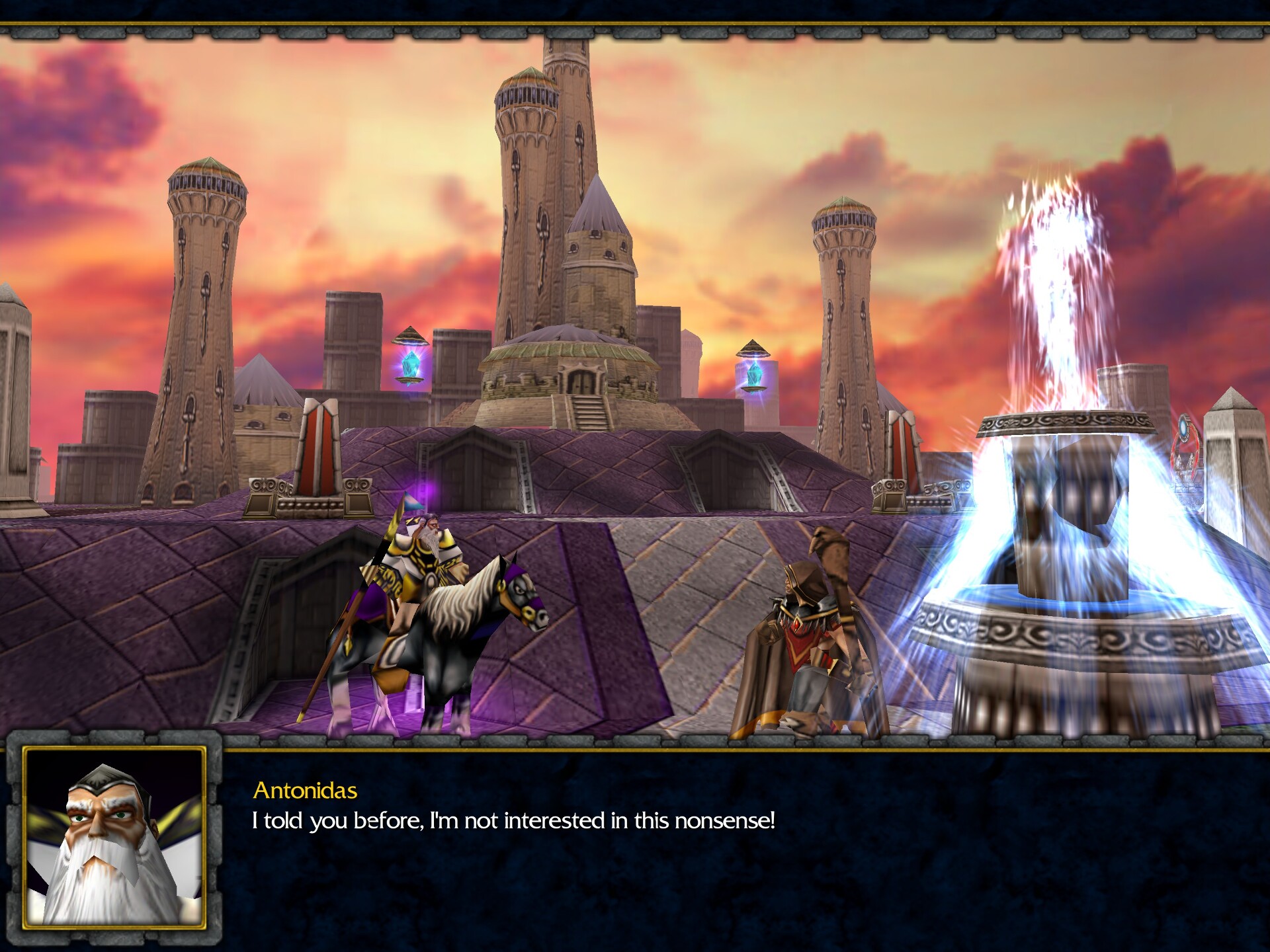
And that makes three leaders the Prophet has tried to convince so far, and the only one who heeded his warnings was a guerilla rebel who had no reason to stay in Lordaeron anyway. That’s not a good track record.
When the Prophet leaves in frustration, it turns out that young Jaina Proudmoore, Antonidas’s student, has been eavesdropping on the conversation through an invisibility spell.
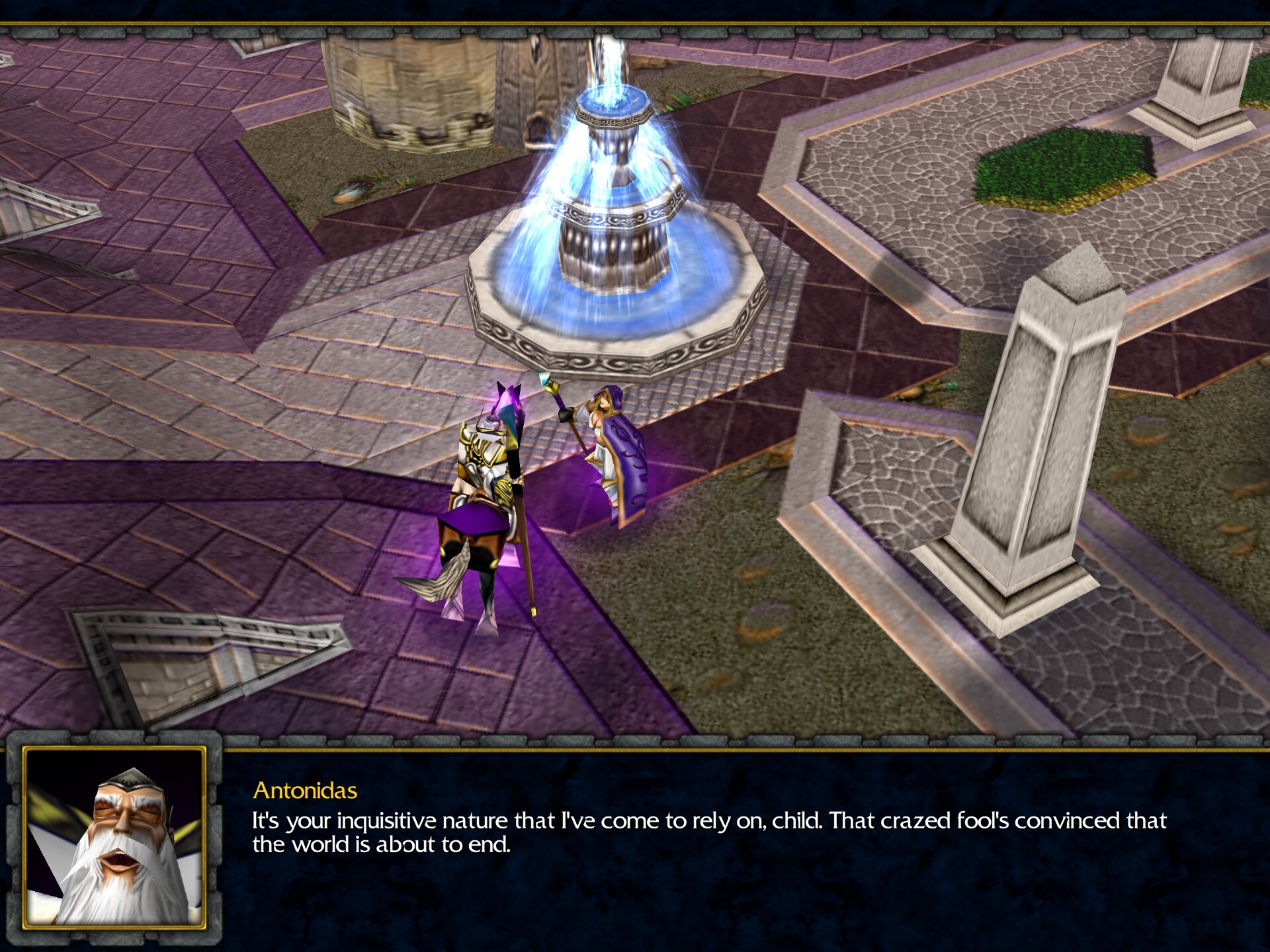
The two teleport to observe elven sorceresses training by turning each other into sheep6, and Antonidas sends Jaina to Lordaeron to investigate reports of the plague. He mentions that he’s arranged to assign her a “special envoy”, who turns out to be…
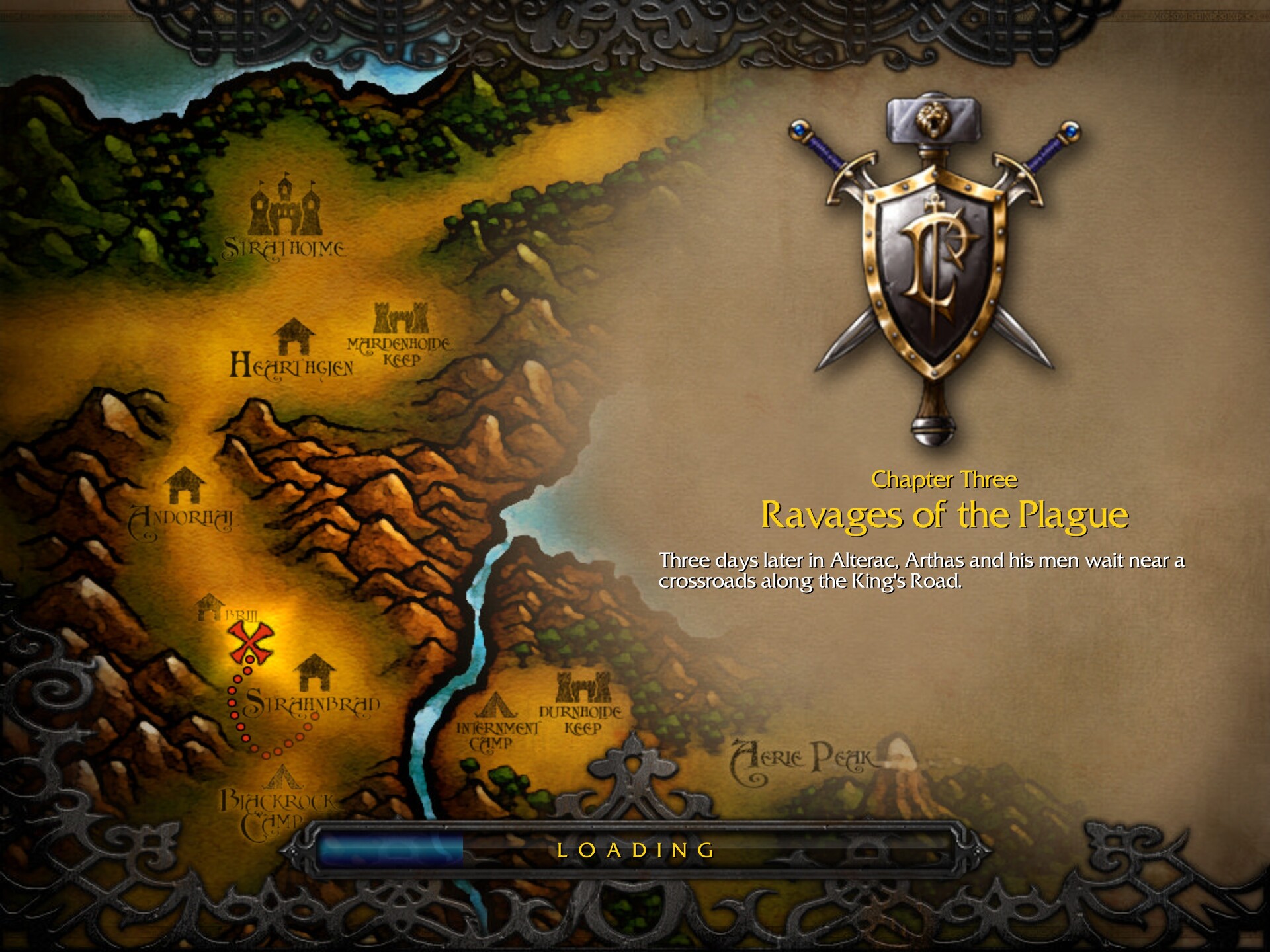
…Arthas, of course.
He’s been waiting for a while, and his companion, the nameless Captain, is getting impatient. Soon, Jaina appears, pursued by two ogres, and proves herself perfectly capable of dispatching them on her own.
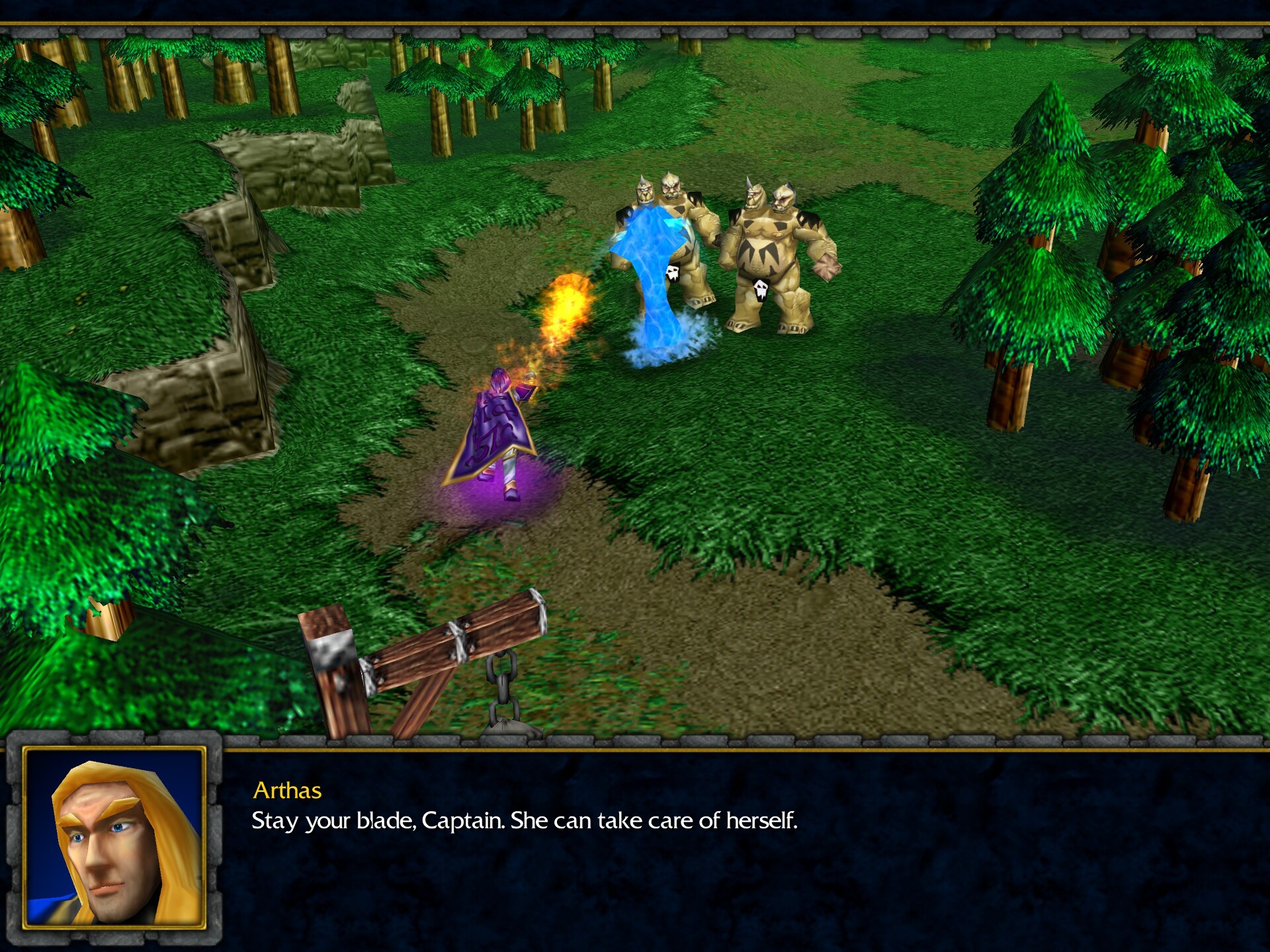
Let’s talk about Jaina. She’s Arthas’s love interest, because no tale of a heroic knight is complete without a love interest, but she quickly establishes herself to be more than just that. Her voice is pretty soft and timid compared to Arthas’s confident bravado, but already we know that she thinks for herself what she wants (she’s the daughter of the ruler of Kul Tiras, but chose to study magic in Dalaran), doesn’t quite play by the rules (she eavesdropped on her teacher’s conversation), and can hold her weight in battle. She doesn’t, however, revel in fighting; whereas Arthas’s attack quotes are all “Feel my wrath!” and “You are past redemption!”, Jaina is all “I hate resorting to violence” and “All I ever wanted was to study”.
This makes her not second fiddle to Arthas, but a genuine foil to him. Arthas is convinced of his own righteousness, while Jaina takes a stance of reserved doubt. For now, she stays in the shadow, fighting because she has to, until a combination of circumstances and uneasy choices will later push her to the forefront.
It’s way too early to talk about the context in which this quote was said, but I think Christie Golden put it best:
Jaina has a very strong core. And when adversity and disaster and personal torment rip her down to nothing but that core, that core is still intact. It’s hurt, but it’s intact.
The mission begins, and once again we’re traveling through the Lordaeron countryside and meeting villagers. However, there’s a sort of foreboding uneasiness in the air, and the color palette is more muted compared to the first mission. Soon enough, we’ll run into our first obstacle — a broken bridge.
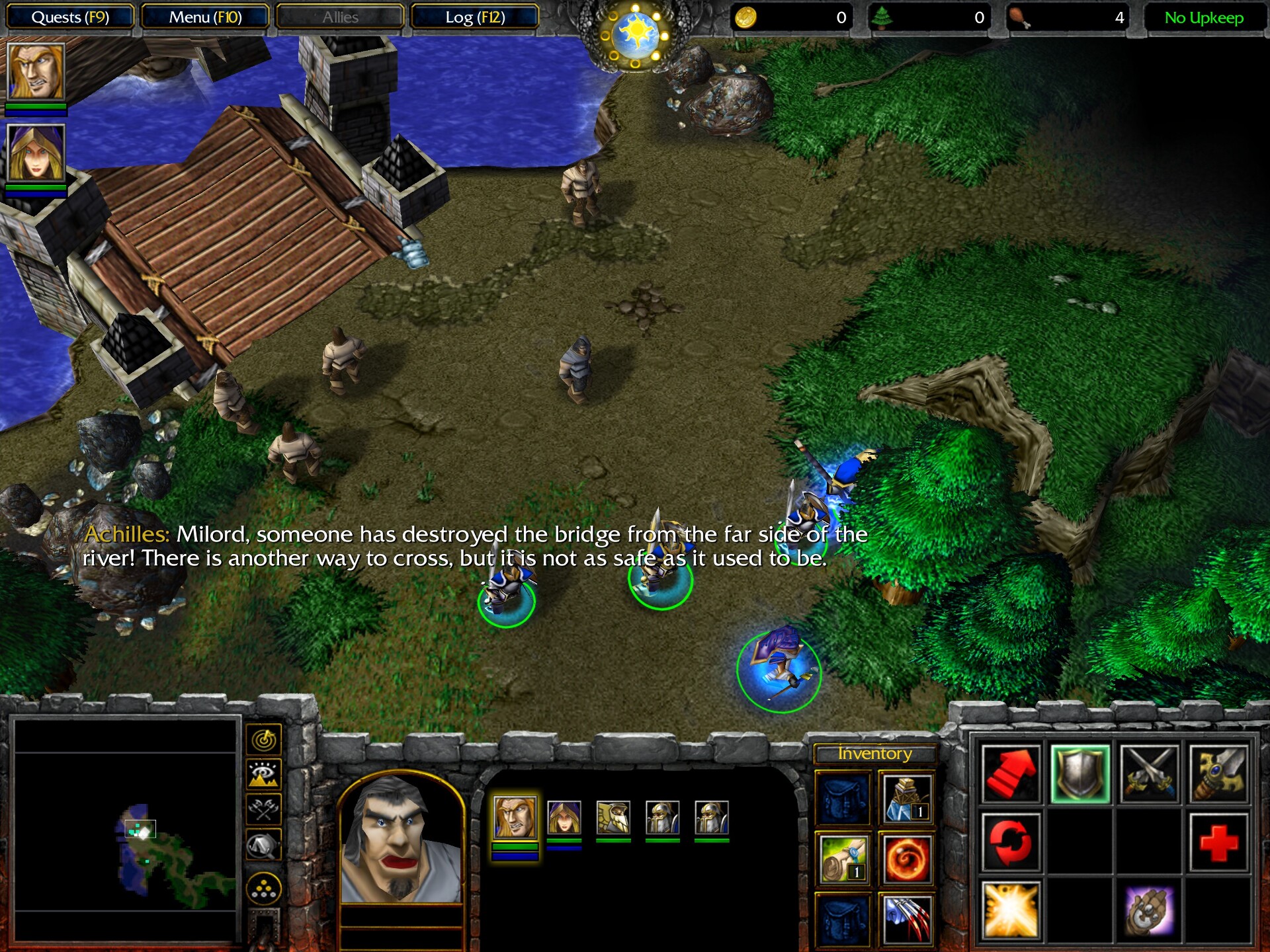
There’s no repairing this one, so we have to go around.
We now have access to a second hero, Jaina the archmage. She starts with the ability to summon a water elemental, and can also learn Blizzard for AoE damage and Brilliance Aura to provide faster mana regeneration to nearby allies. Even better, she provides six more inventory slots to carry all the sweet loot we’re swiping along the way.
We also get our sidequest, such as it is: to visit the Fountain of Health in the northwestern corner of the map.
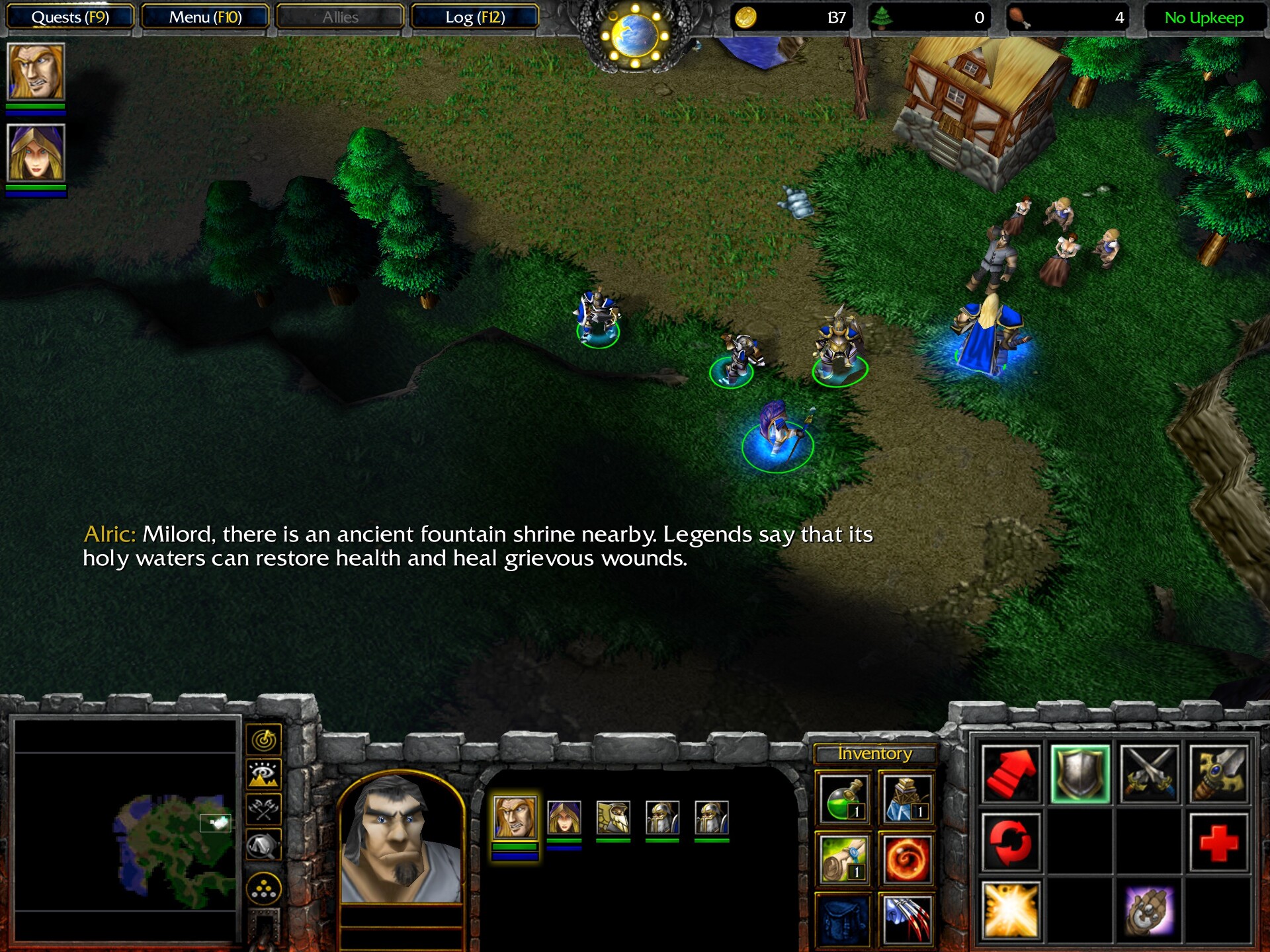
We make our way across the river ford in the north, through bandits and murlocs, to find the other riverbank in a ghastly state. The houses and the crops are burned down, and the local footmen are fighting… undead?
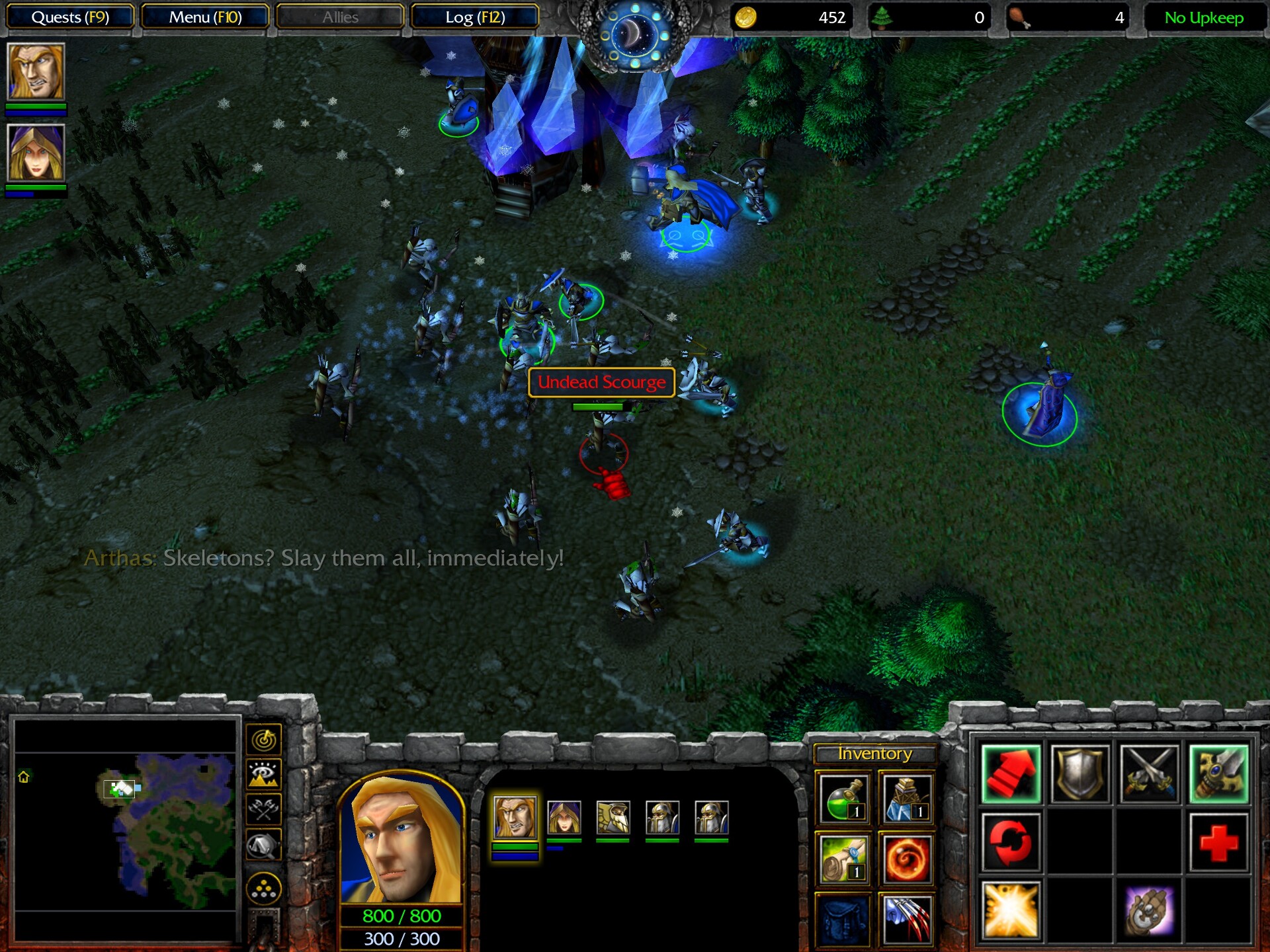
If you’re quick enough, you can save all three footmen by healing them with Arthas — annoyingly, you have to target the actual units on the map, since they’re not under your control yet. The surviving footmen join us, and after recuperating at the Fountain of Health (and completing the side quest), we head south to find… this.
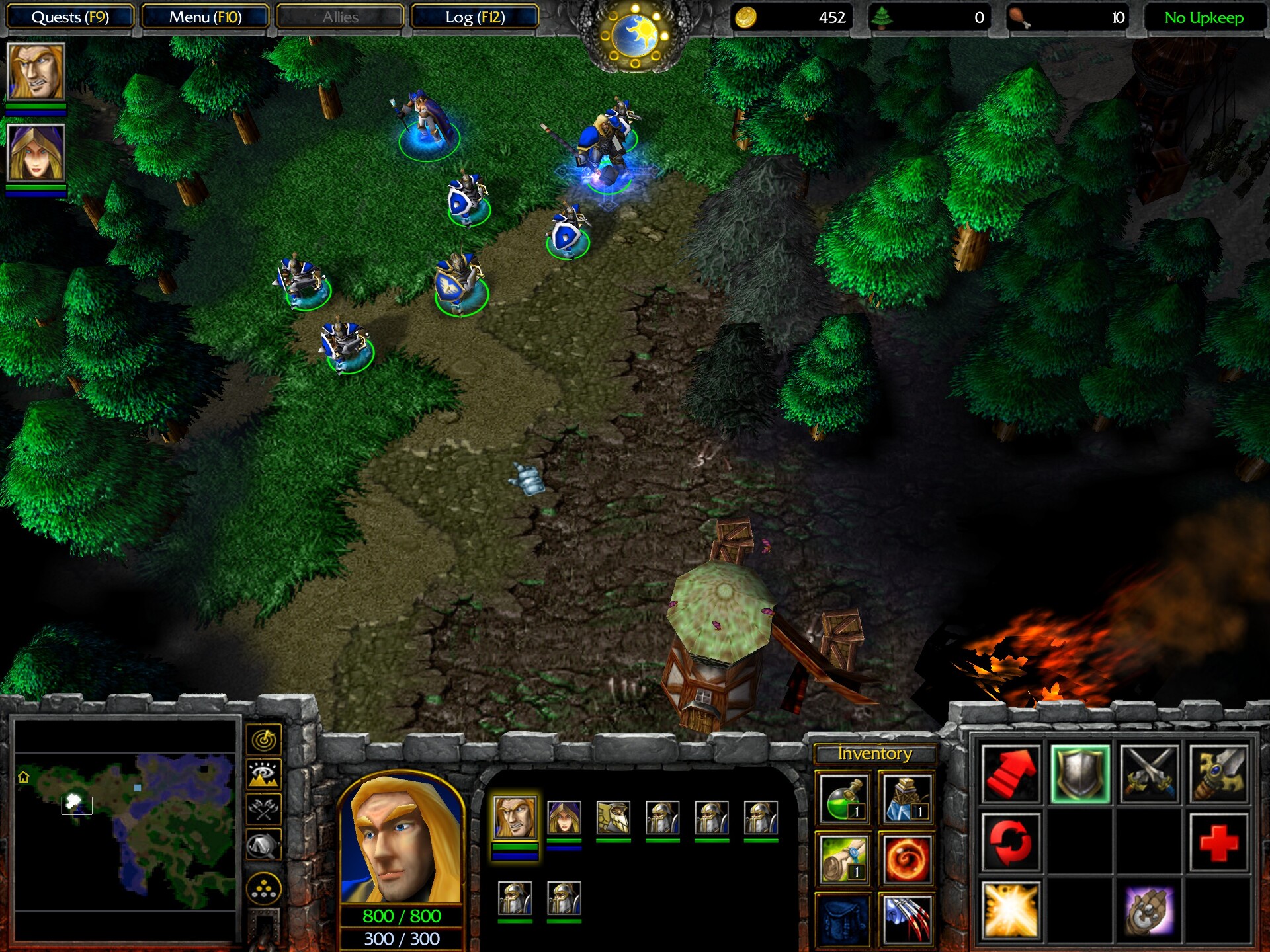
The patch of land around the granary is afflicted by blight, the unique mechanic of the undead faction in Warcraft 3. When an undead building is constructed, it spreads blight around itself, poisoning the land and the trees, and most undead buildings — all but two — can only be constructed on blight, making it similar in this way to zerg creep in Starcraft. Approaching the granary triggers a cutscene where Arthas worries that the grain itself might be plagued.
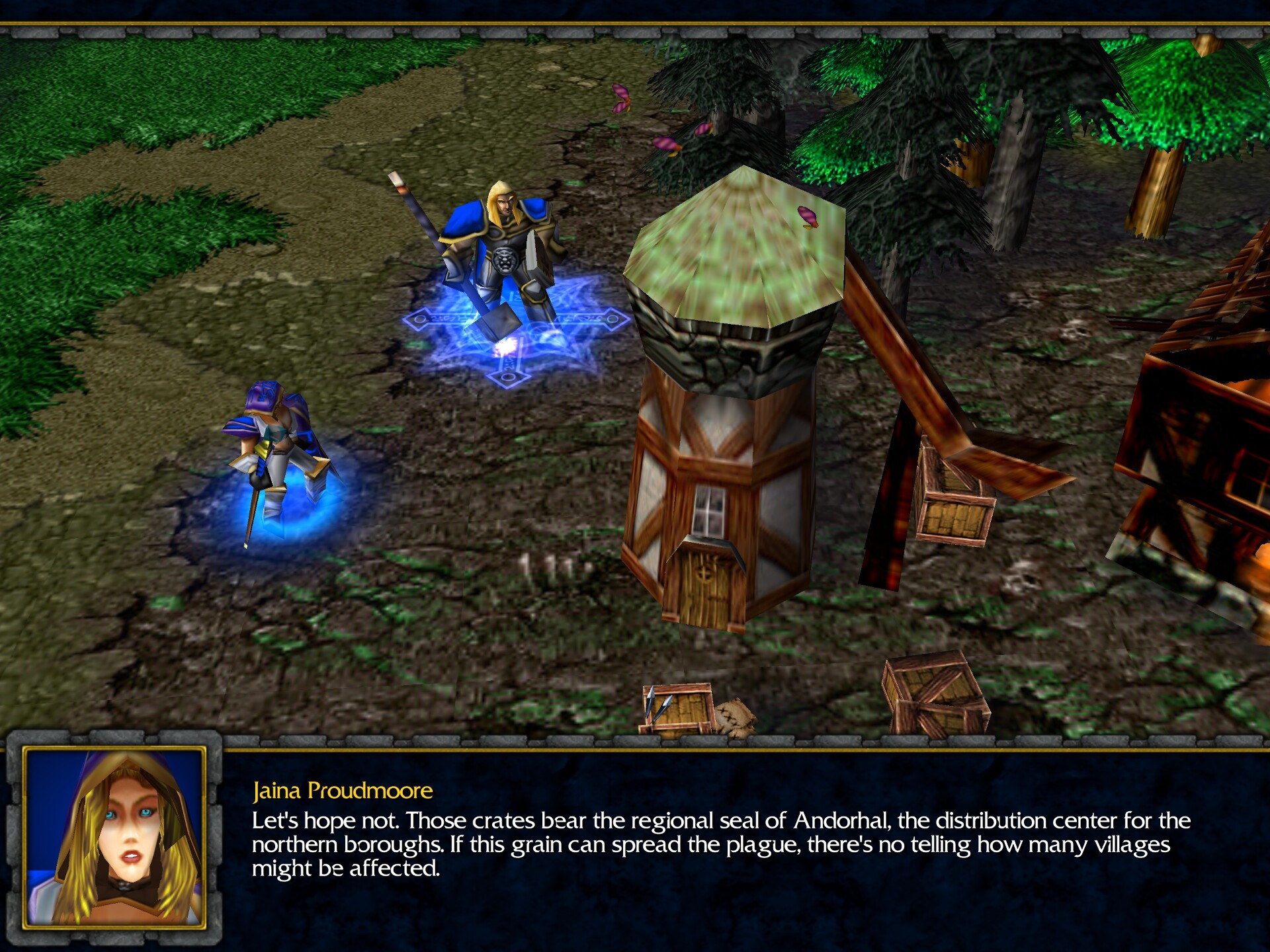
We destroy the granary (with Arthas, hilariously, shouting things like “Foul knave!” and “Betrayer of the Light!”) even when attacking buildings). Later along the way, we’re joined by two elven priests, who have come to heal the land, and a dwarven mortar team. Finally, our Alliance starts actually feeling like an alliance.
Investigating where these skeletons come from, we find a pretty sweet Mantle of Intelligence +3, which of course goes to Jaina.
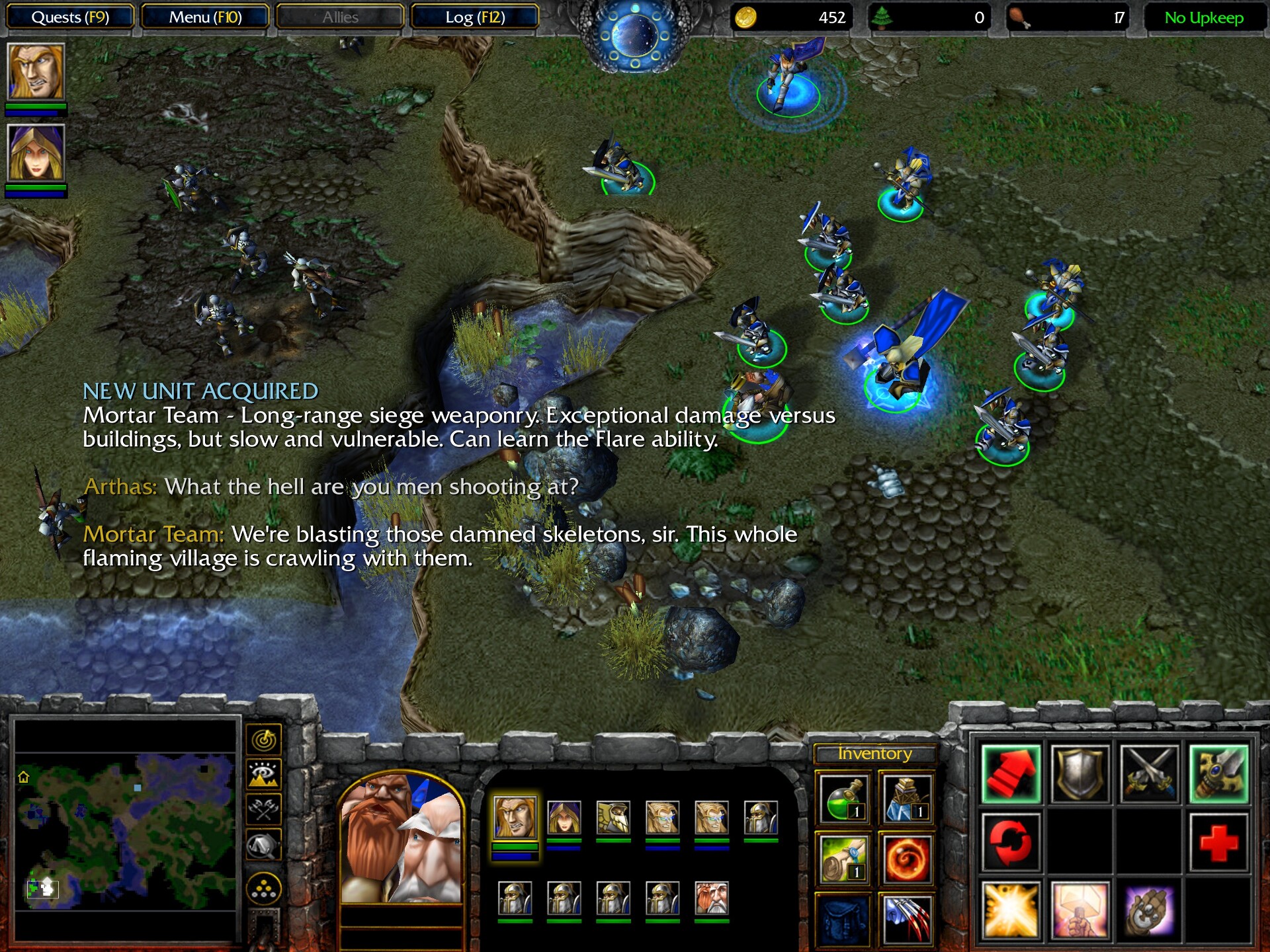
The mortar team is a siege unit, hurling siege projectiles that are effective against buildings but not as effective against everything else. Priests are squishy support casters best kept in the rear. They follow your units and continuously heal them — not for much at once, but they’re basically walking heal-over-time effects, in contrast to the paladin’s Holy Light, which is a strong but long-cooldown heal. Priests can also learn Dispel Magic, an AoE spell that removes magic effects in an area and deals damage to summoned units — including skeletons raised by undead necromancers.
Speaking of necromancers, we run into one. And he has a name.
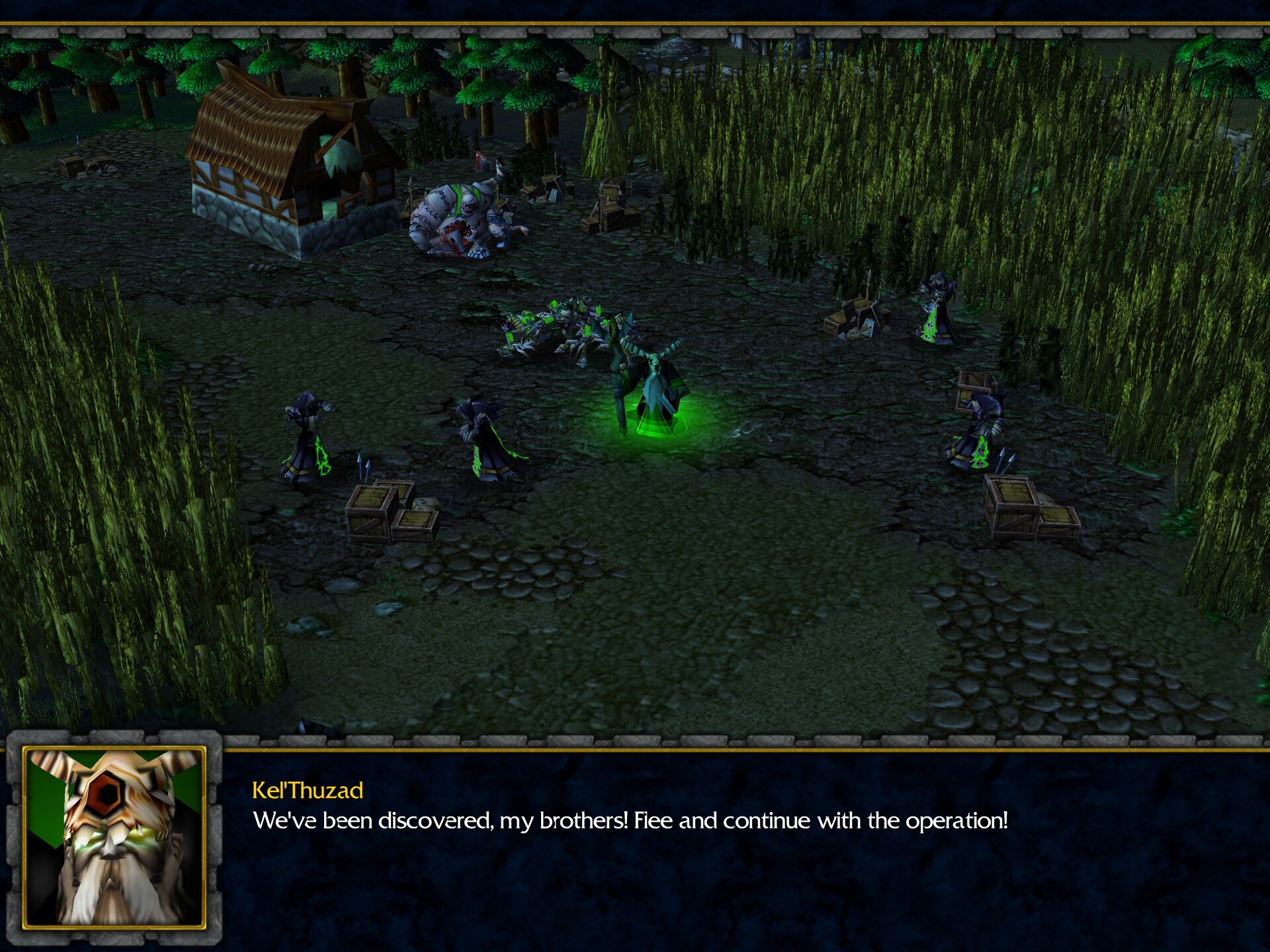
But we don’t get to fight him in this mission, as he flees, along with his followers. Instead, we fight that thing behind him, sewn together from different corpses. We also destroy the plagued grain warehouse. Jaina realizes that the necromancer and his lackeys are behind this plague, and suggests looking for answers in Andorhal — the center of grain distribution.
The Cult of the Damned
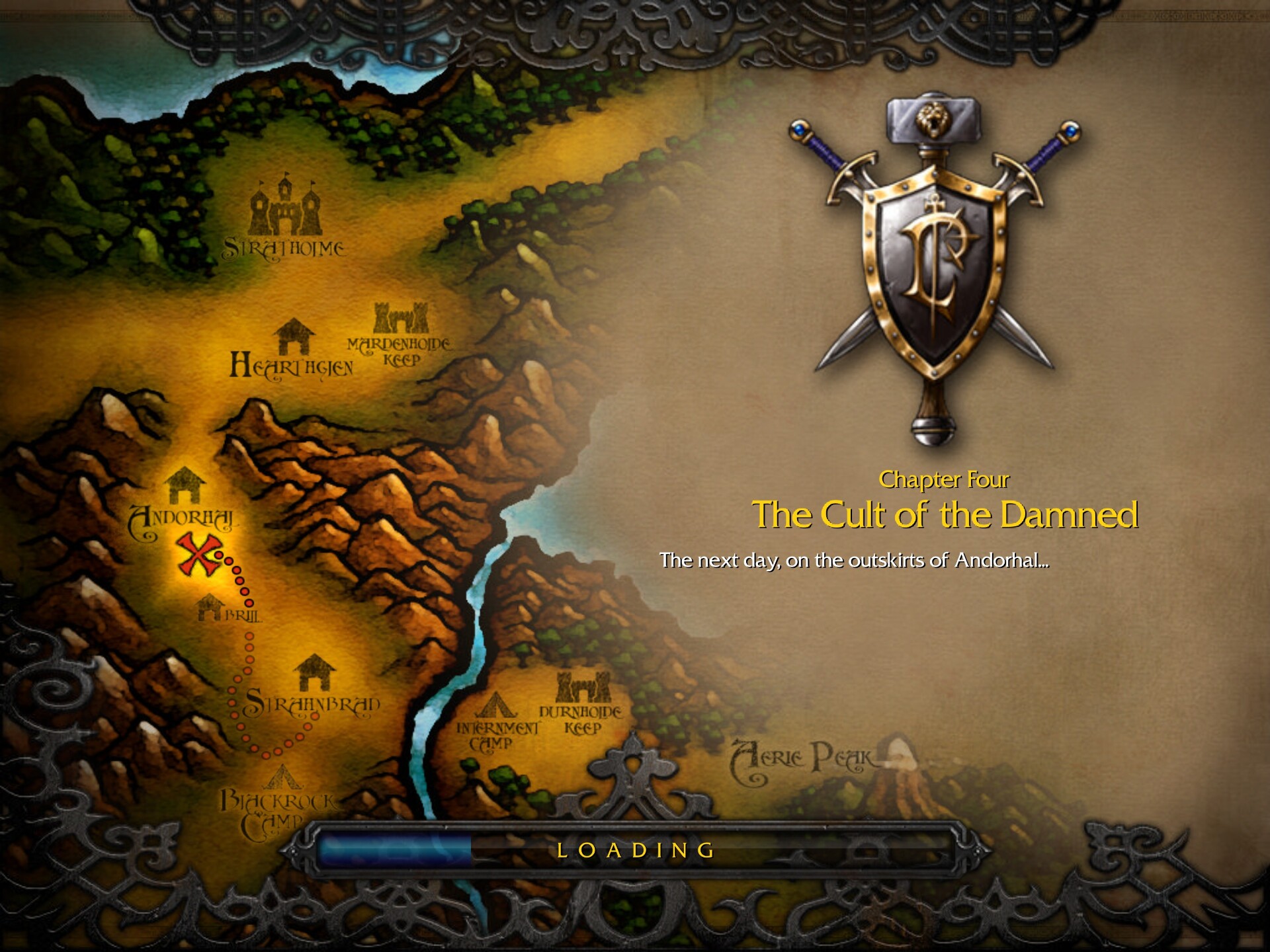
Arthas and Jaina have found the cultists, who are doing… something to the gold mine.

These cultists are actually acolytes — the worker units of the undead faction. Before an undead player can harvest gold from a gold mine, they have to construct a special building on top of it — a Haunted Gold Mine, which spreads blight around itself when built. Here, however, our heroes chase the acolytes away, killing one, and Arthas suggests erecting a base camp here around this very mine. Suddenly, peasants walk in from… a pocket dimension, I guess? — and begin building a town hall and barracks.
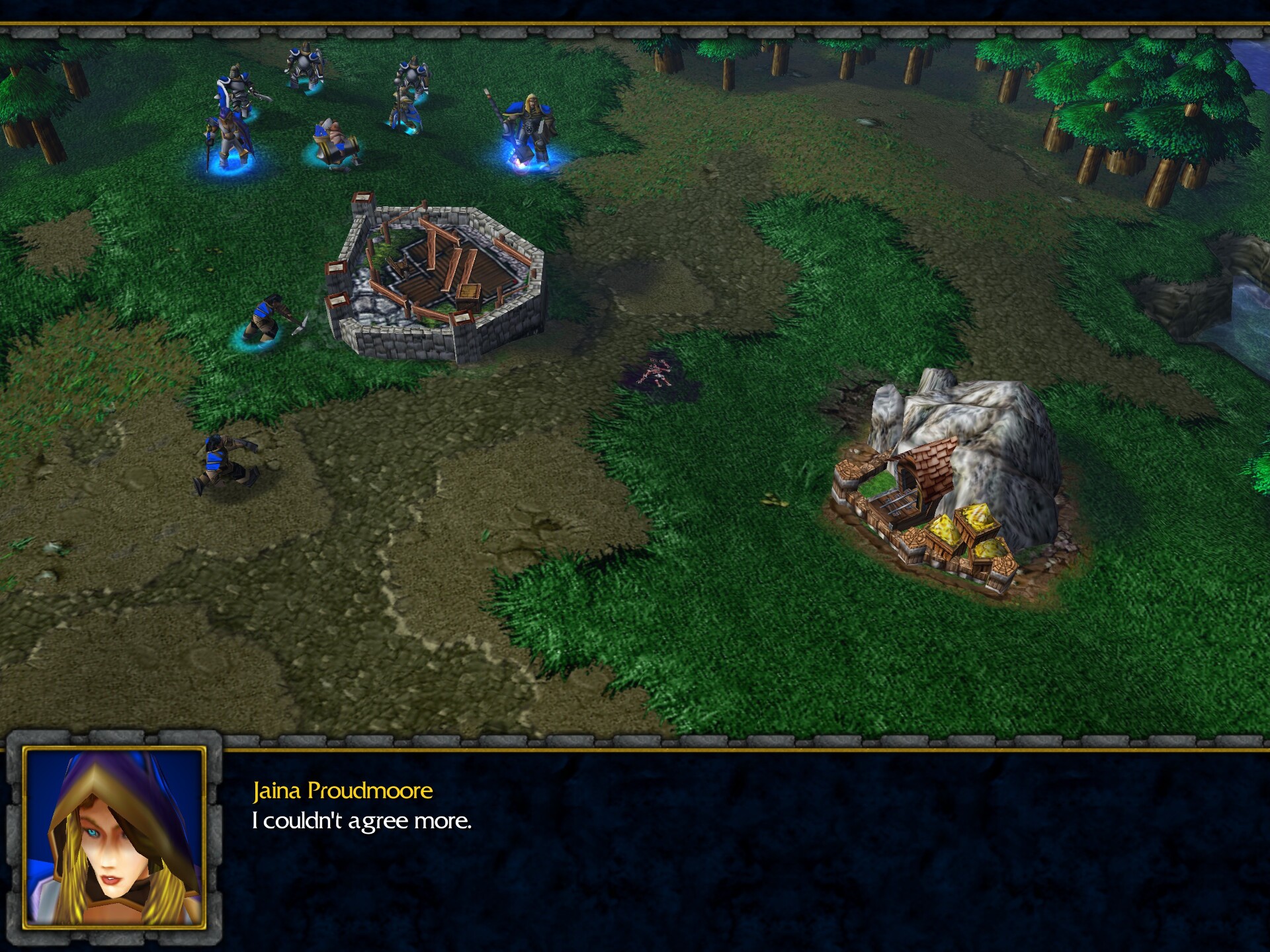
Now, the game expects you to wait until the base is built, develop it, defending it from undead attacks, and then launch the assault on the nearby undead base. However, on normal difficulty, you actually start with enough forces to destroy the undead base right away, making the rest of the mission a complete cakewalk.
While my base was still under construction, I grabbed all my starting units and immediately went northwest. The undead base had some ghouls and a necromancer, but this early on it had only two buildings capable of doing damage — the necropolis and one spirit tower. Between Arthas’s Holy Light, Jaina’s elemental and blizzard, and the mortar team launching cannons from a distance, one can destroy this base before it even becomes a threat.
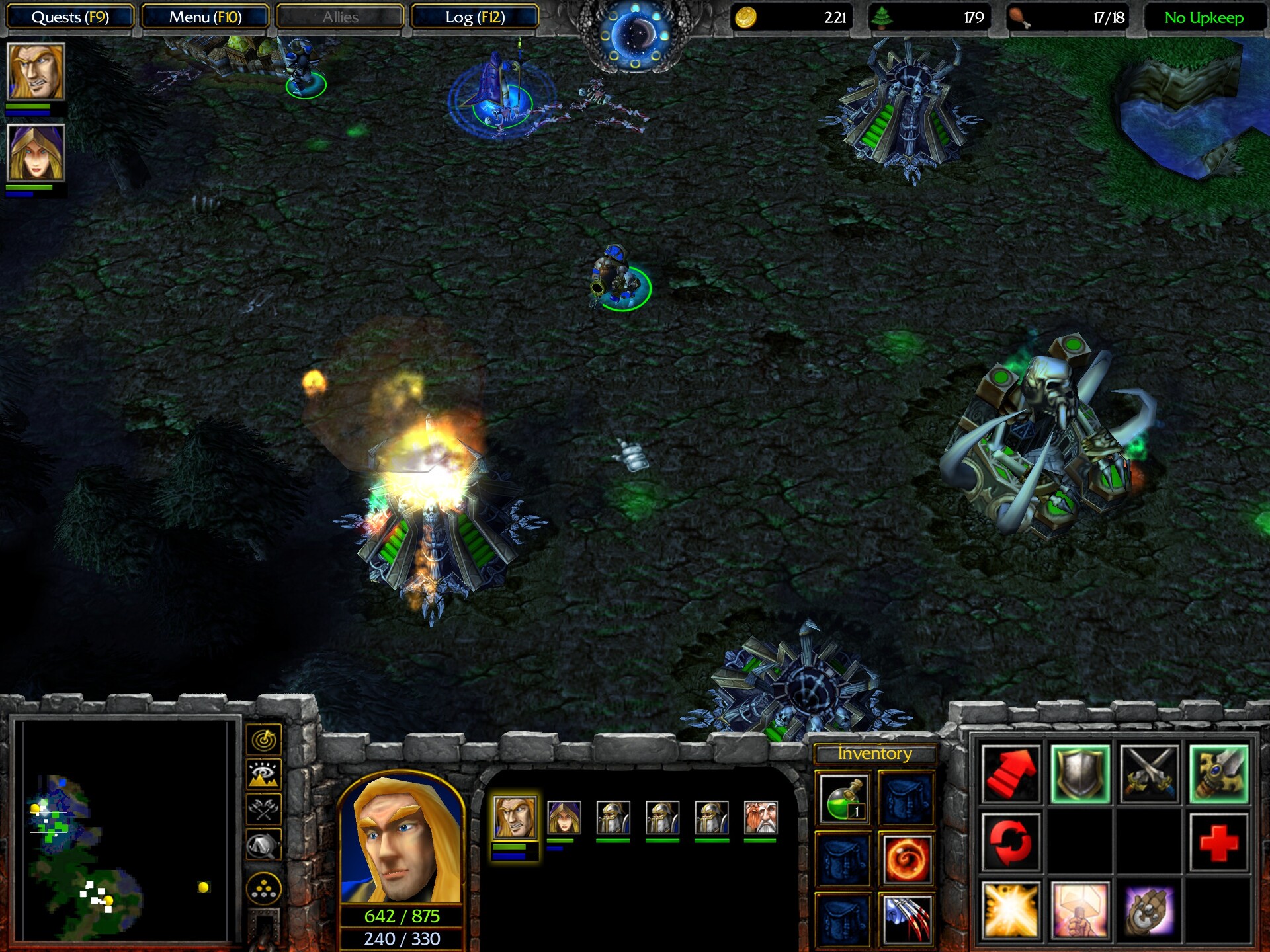
With all real opposition gone, I was free to explore the map, fight creeps, level up, and snag shinies in the east. Of particular note is the Goblin Merchant, a building that sells items for gold.
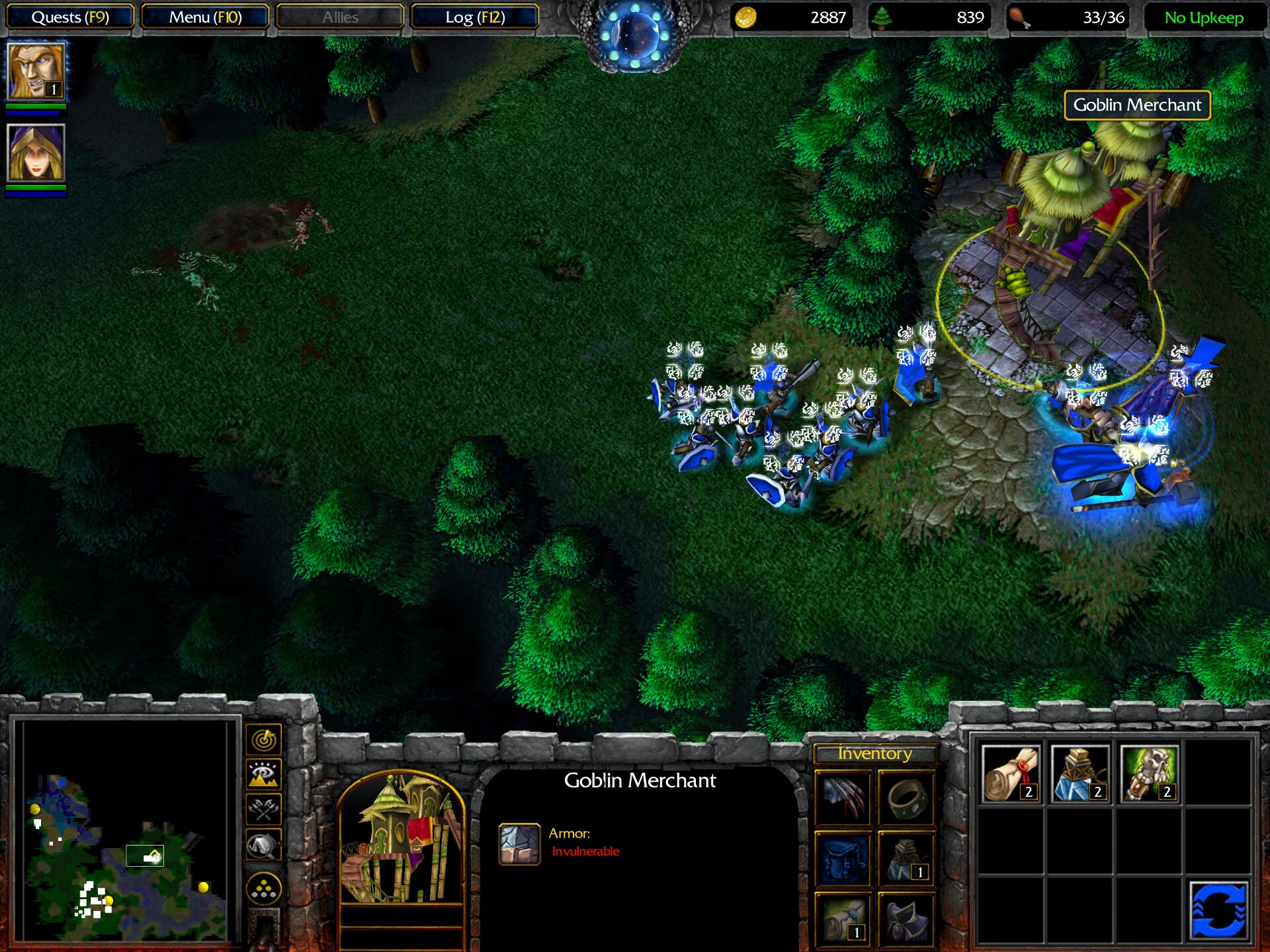
In Warcraft 2, goblins provided zeppelins, sappers, and giant turtle riders to the Horde. In Warcraft 3, they’re still into wacky steampunk science (as we’ll see later), but now they no longer choose sides. Instead, they’ve become equal opportunity shady dealers, and it’s this characterization of them that will persist into World of Warcraft.
Personally, on this map, I even took the opportunity to engage in a little roleplaying. I constructed my lumber mill at the site of the former undead base. When a non-undead faction constructs a building on blight, it purges blight from the ground around it, but the trees stay blighted. Mechanically, blighted trees work the same as healthy trees, so I sent my peasants to chop the blighted trees only and leave the healthy ones standing.
The priests’ Dispel Magic also clears blight in its area of effect, so I sent two priests to heal the land while my main party was busy killing sentient creatures around the map and taking their stuff.

When there’s nothing left to explore, we cross the only intact bridge into our real objective: Andorhal. Oh my. What happened here?
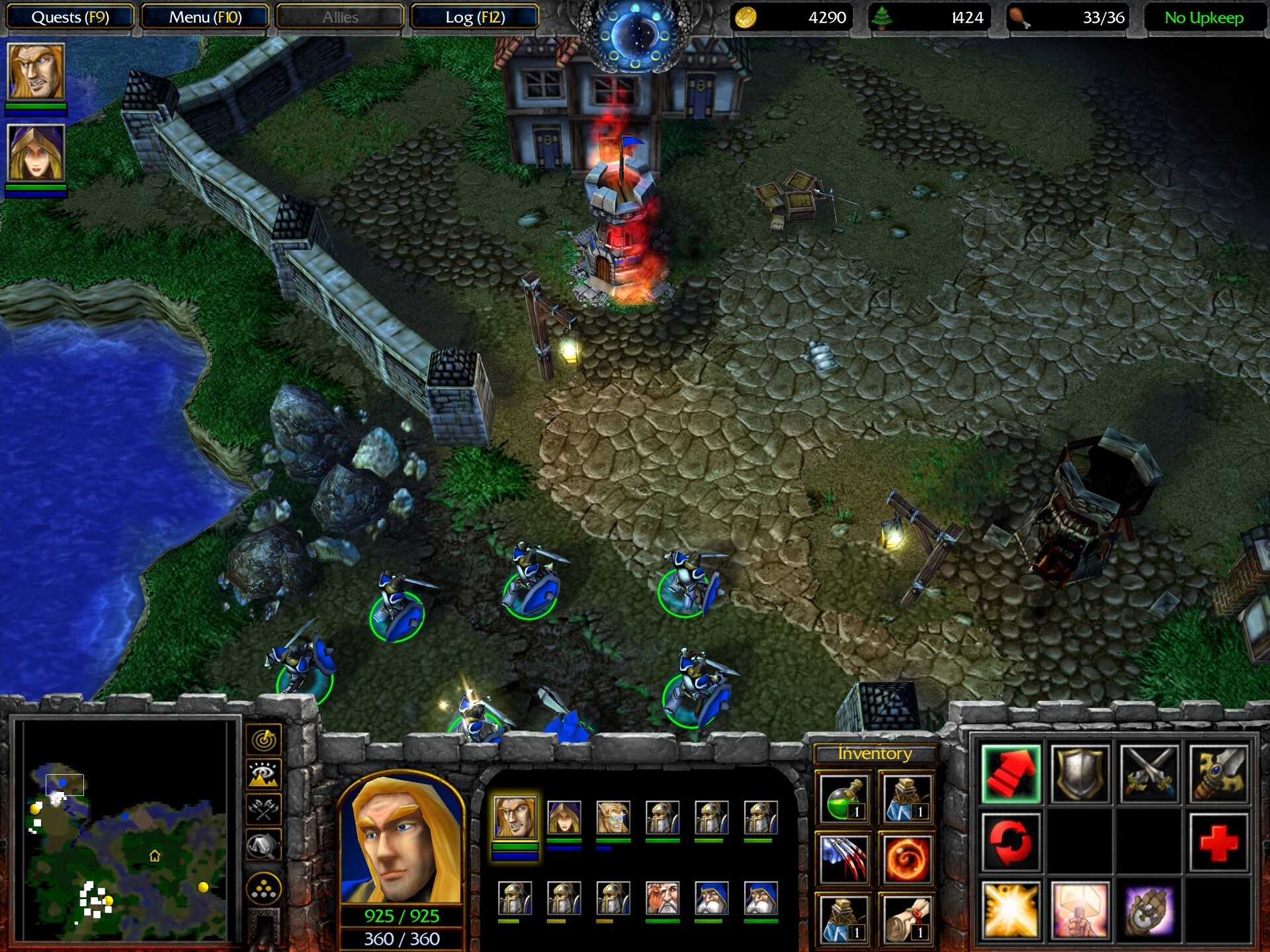
We find Kel’Thuzad, who introduces himself and explains everything. He ordered the Cult of the Damned to plague the grain, but he himself serves the dreadlord Mal’Ganis, who commands “the Scourge that will cleanse this land and establish a paradise of eternal darkness” — from the city of Stratholme.
We fight some undead minions and explore some more, finding another Timmy (who’s a ghoul). Arthas realizes, to his horror, that the granaries are empty — the plagued grain has already been distributed. All that’s left to do here is to kill Kel’Thuzad, who, being just a human necromancer, goes down easily — but not before leaving a cryptic warning.
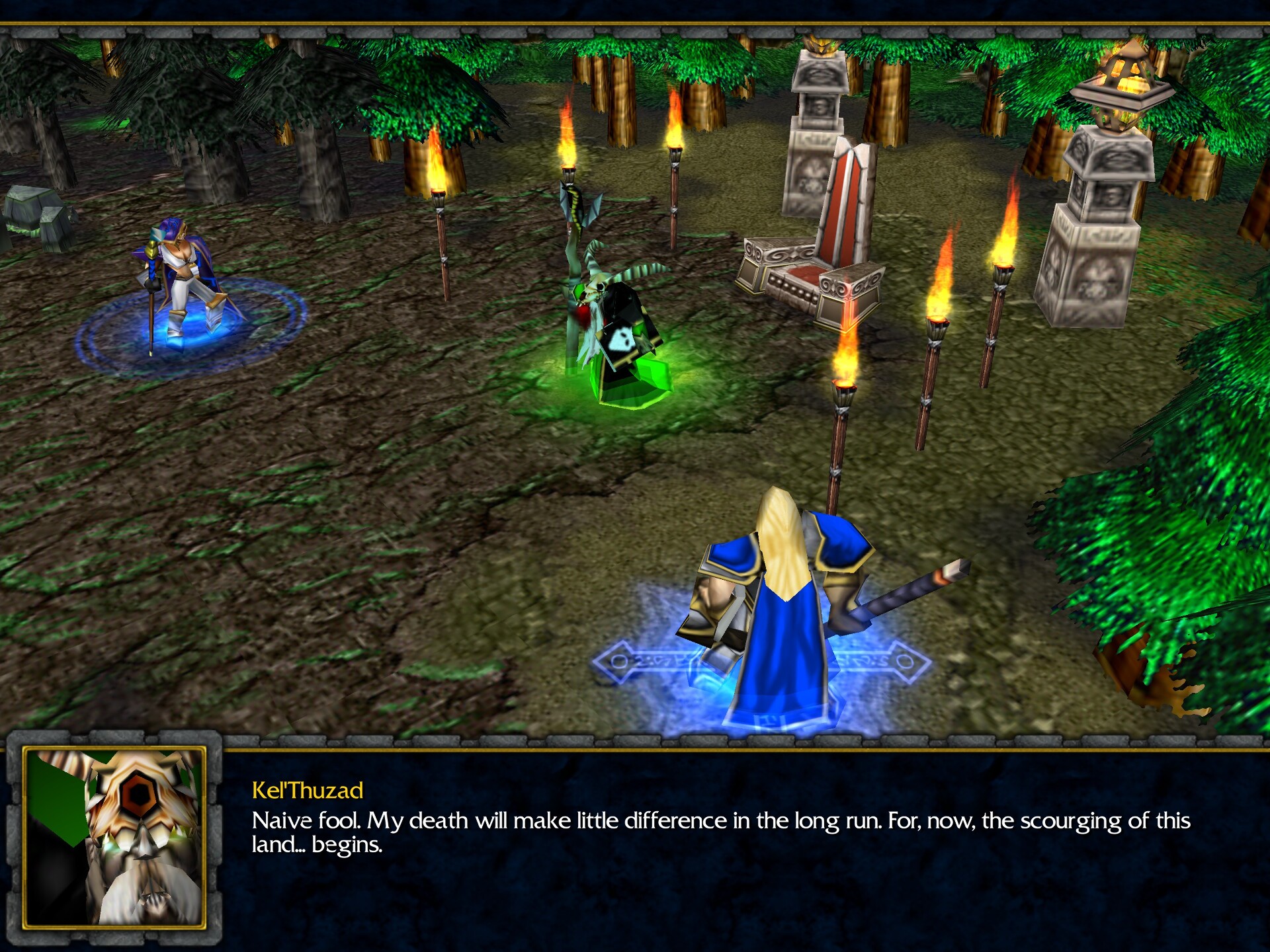
March of the Scourge
Unfortunately, these two missions are the only ones were we get to control Jaina. She doesn’t even make it to level 6 to let us unlock her class’s ultimate ability, Mass Teleport.
Part of it is because Jaina was originally supposed to die in the Cult of the Damned mission. They discarded this idea early on, in part it was because it was “too Raynor and Kerrigan again”, and Arthas had enough motive to pursue Mal’Ganis as it is. However, the official strategy guide was never updated to reflect this plot change, and still claims she dies.
For now, we head farther north, towards Stratholme and a confrontation with Mal’Ganis.
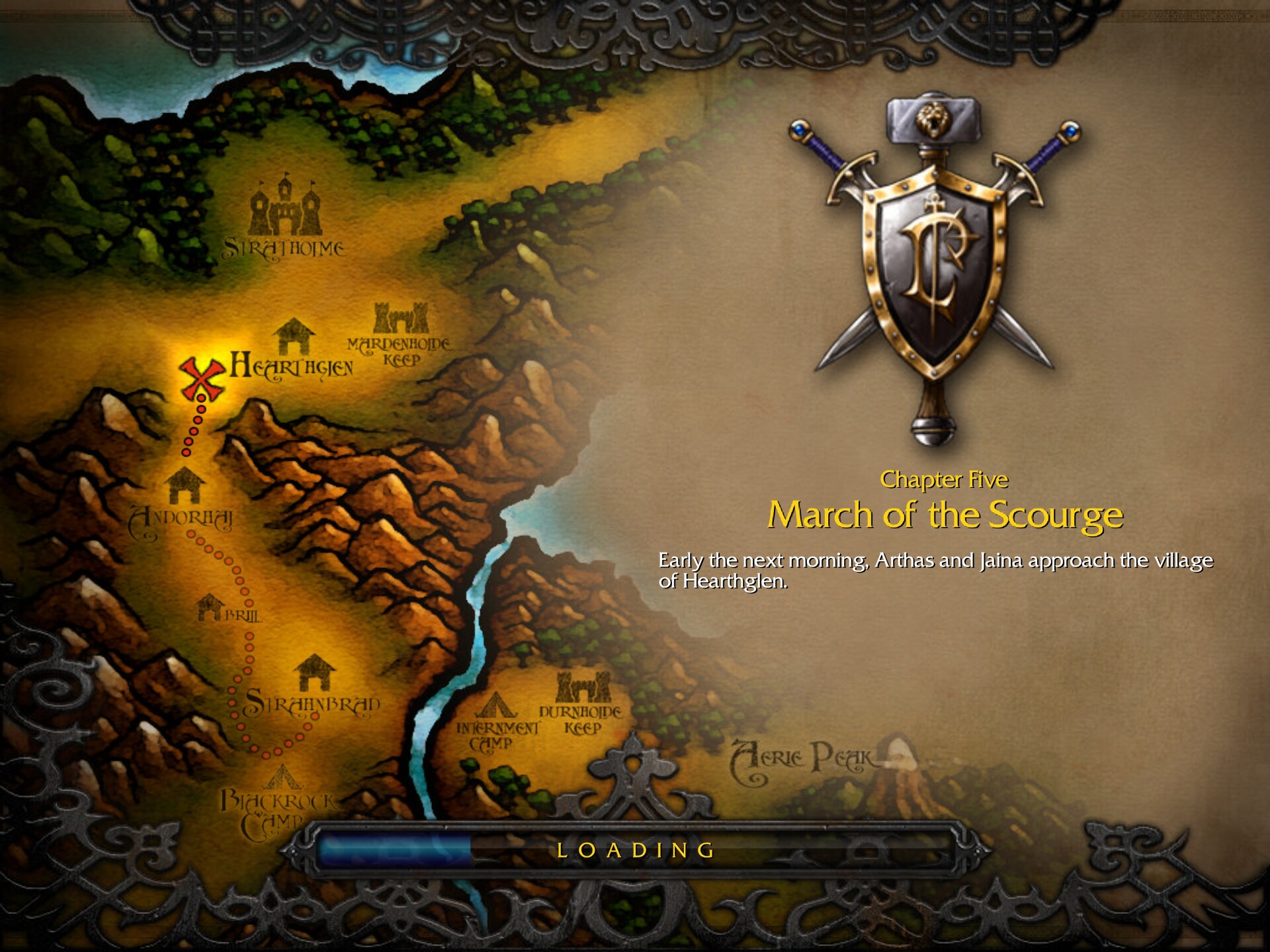
Arthas and Jaina reach the village of Hearthglen, hoping for some rest, but instead find the local soldiers training for battle. They learn that a vast undead army has emerged and began attacking villages at random. In desperation, Arthas tells Jaina to go and ask Uther for help while he himself stays to protect the village.
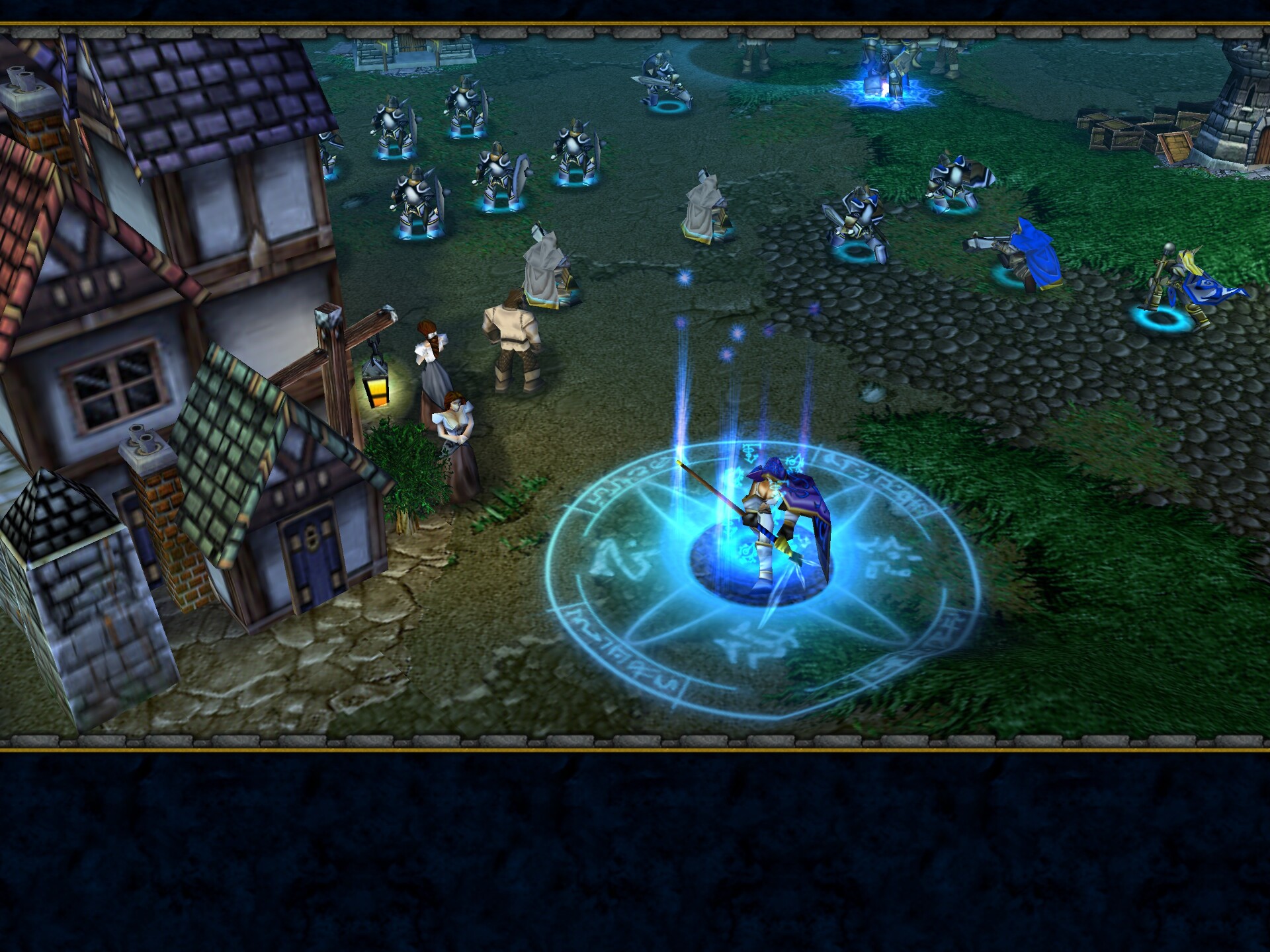
Arthas notices empty grain crates from Andorhal lying around. The footman tells them they’ve already been distributed across the villages, and Arthas has a horrifying realization.
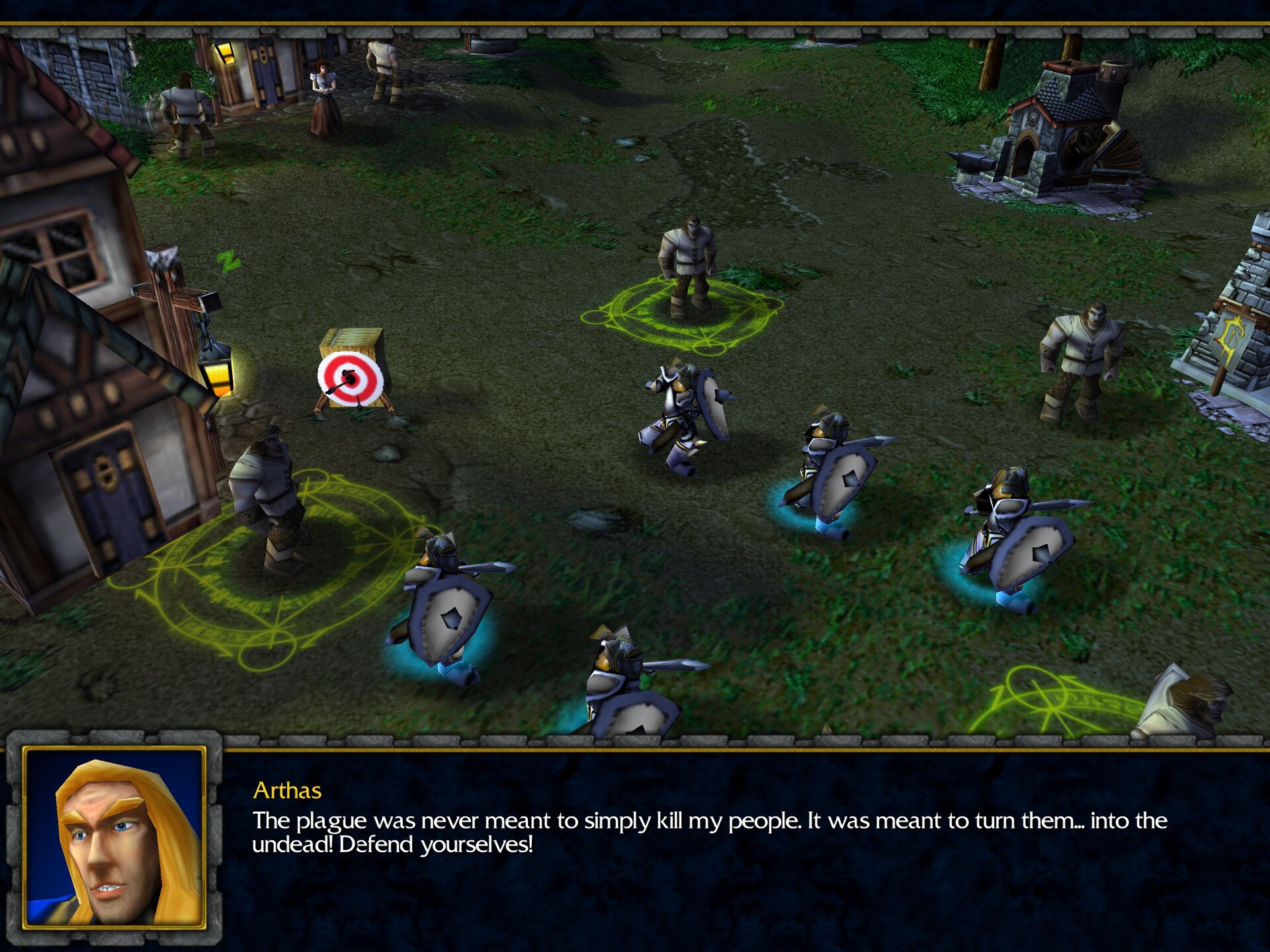
The villagers turn into zombies, who attack. Once they’re dead, there’s a little time to look around. Warcraft 3 developers actually took an effort to avoid the problem where a character leaves for plot reasons and takes all their gear with them: whenever a hero permanently leaves our control, like Jaina here, their items are laid on the ground near the player’s starting point. On the other hand, that Jaina’s items are left behind means we won’t be controlling her again.
We get our objective: to survive for 30 minutes until Uther arrives with reinforcements. I immediately train a lot of peasants and send them to build towers at the three chokepoints that the undead attack.
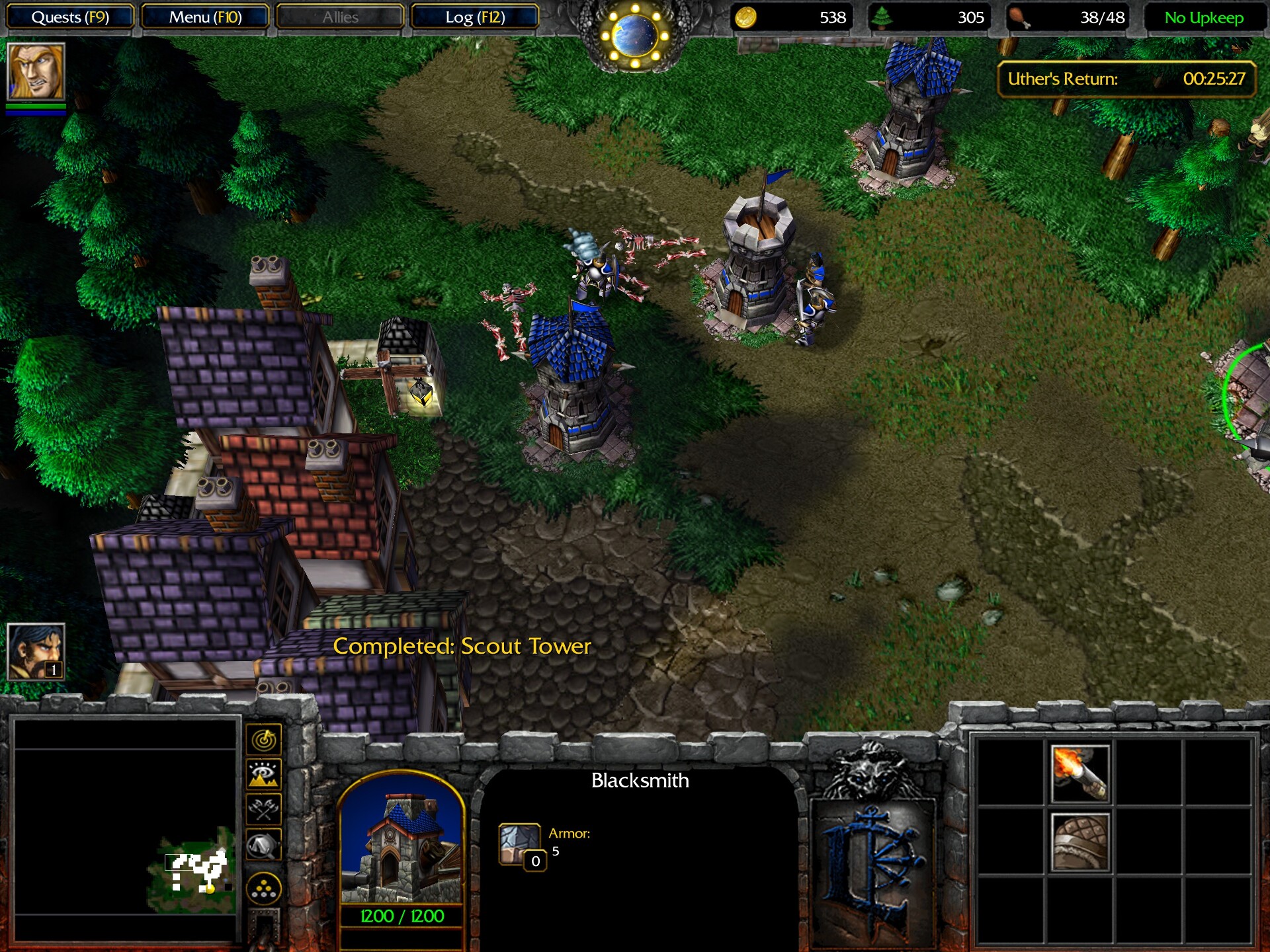
Human towers work a little oddly. Peasants build Scout Towers, which by themselves only provide a sight range, but can be upgraded into either fast Guard Towers, or Cannon Towers that have a slow rate of fire and can’t attack air units, but pack a lot more punch per shot.
The reason I’m training extra units at the base is because we have an optional quest: to intercept a plagued grain caravan heading across the outlying villages. I gave the undead bases a wide berth and took my starting force, including Arthas, and destroyed the caravan before it became a problem.
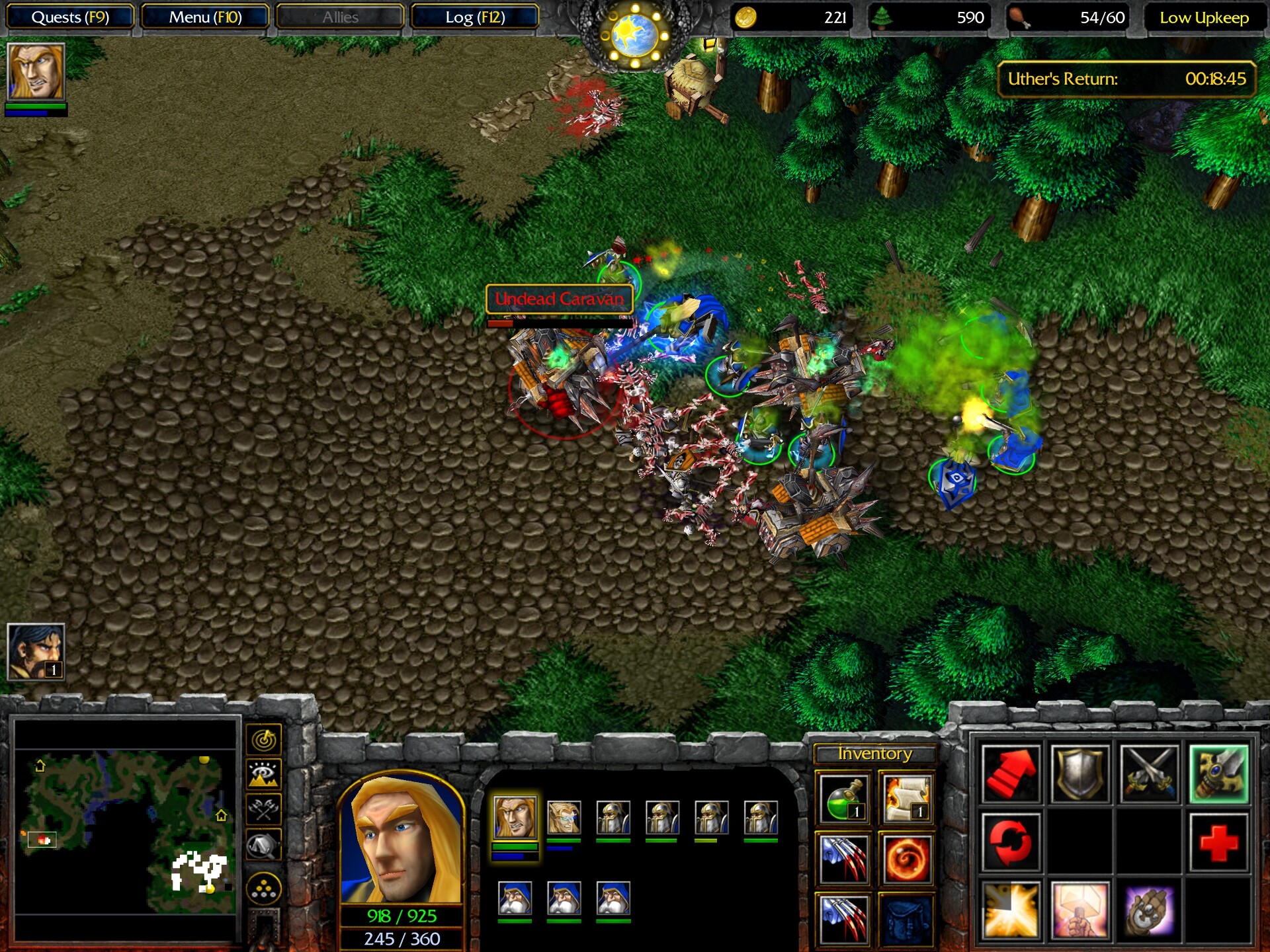
I bought a Scroll of Town Portal at the goblin merchant to quickly return to my base, but it turns out I didn’t have to bother: the caravan drops one. With the side quest completed and some ogre creeps cleared, Arthas gets enough experience to learn his ultimate ability: Resurrection, which brings six nearby allied units back to life. Now it’s just a matter of turtling at the base and weathering enemy attacks with towers, until with forty seconds left, the undead throw everything they have at all three chokepoints.
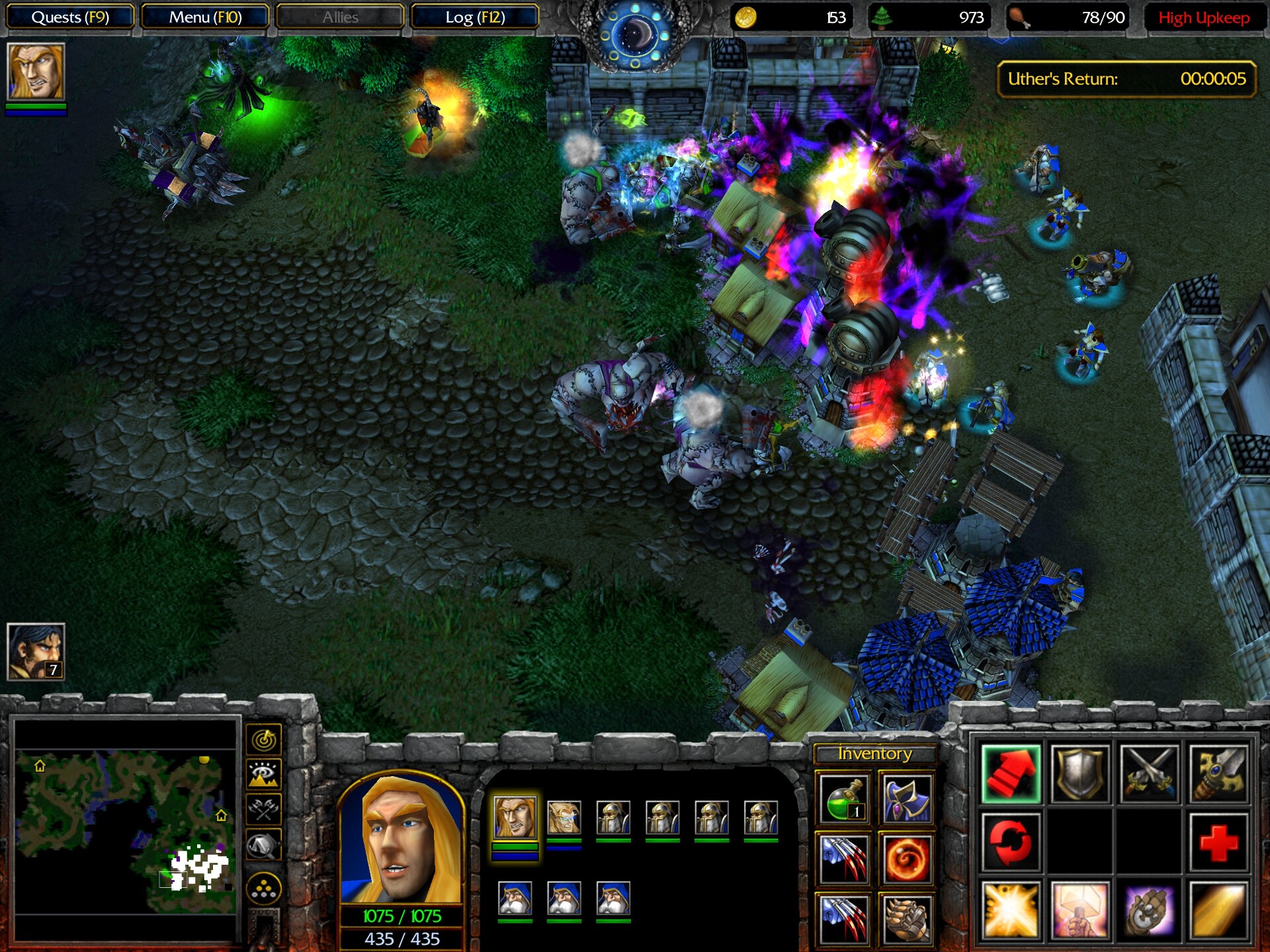
Except it turned out I goofed up! In my excitement over completing the side quest, I completely forgot to loot the items dropped by the caravan, including the very useful Medallion of Courage, which provides +4 to both Strength and Intellect. So after completing the mission, I reloaded my last save, with 40 seconds remaining, and beelined across the entire map with Arthas alone, past a very confused undead army, to pick up the loot.

The mission is complete. The undead overrun Hearthglen, but at the last moment, Uther arrives at the head of a squadron of knights.
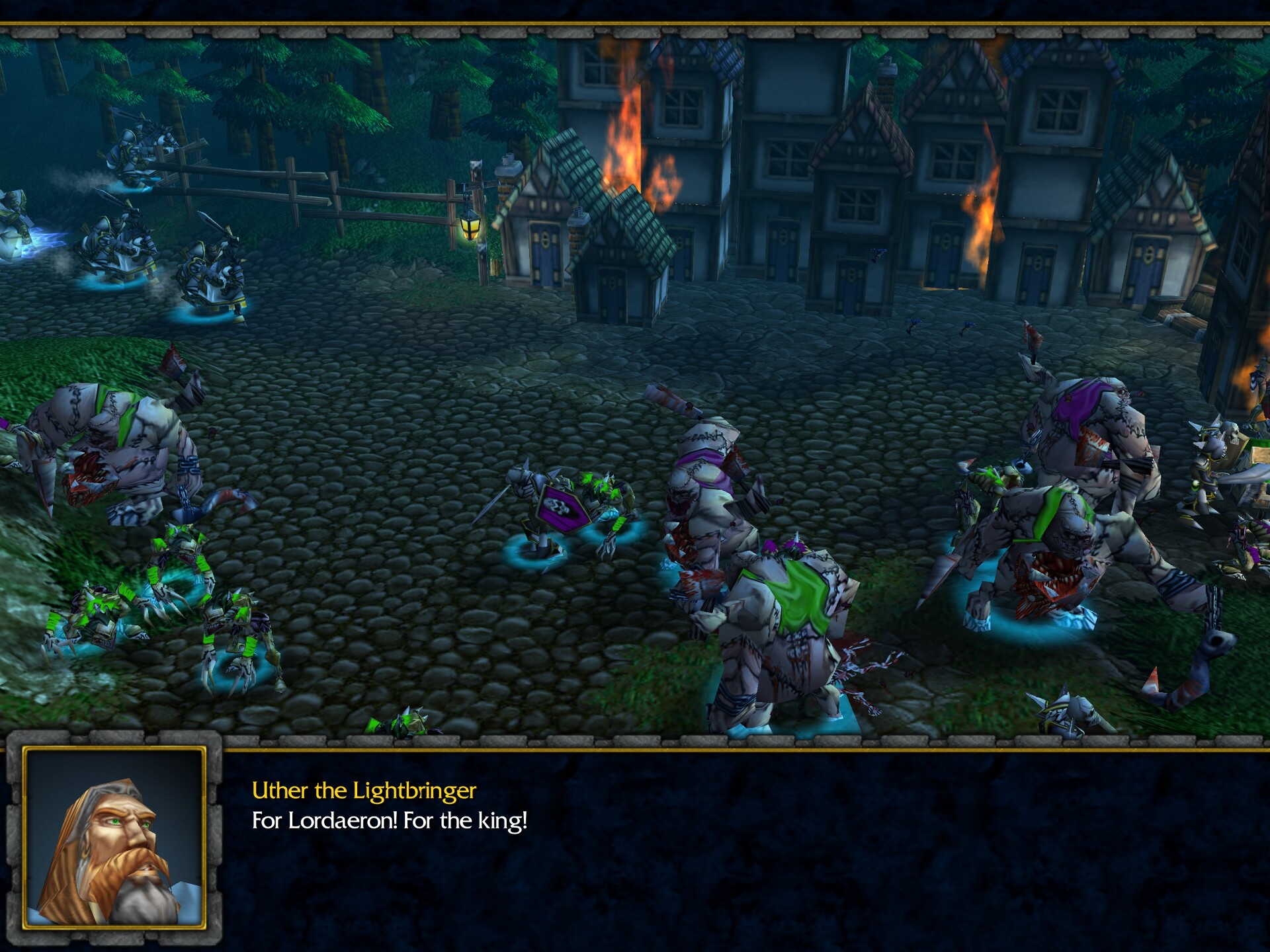
Arthas, however, is acting kind of cranky and dismissive towards the man who just saved his bacon.
Uther: I’m surprised that you kept things together as long as you did, lad. If I hadn’t arrived just then–
Arthas: Look, I did the best I could, Uther! If I’d had a legion of knights riding at my back, I would’ve–
Uther: Now is not the time to be choking on pride! What we faced here was only the beginning. The undead ranks are bolstered every time one of our warriors falls in battle.
Arthas: Then we should strike at their leader! I’ll go to Stratholme and kill Mal’Ganis myself if I have to!
Uther: Easy, lad. Brave as you are, you can’t hope to defeat a man who commands the dead all by yourself.
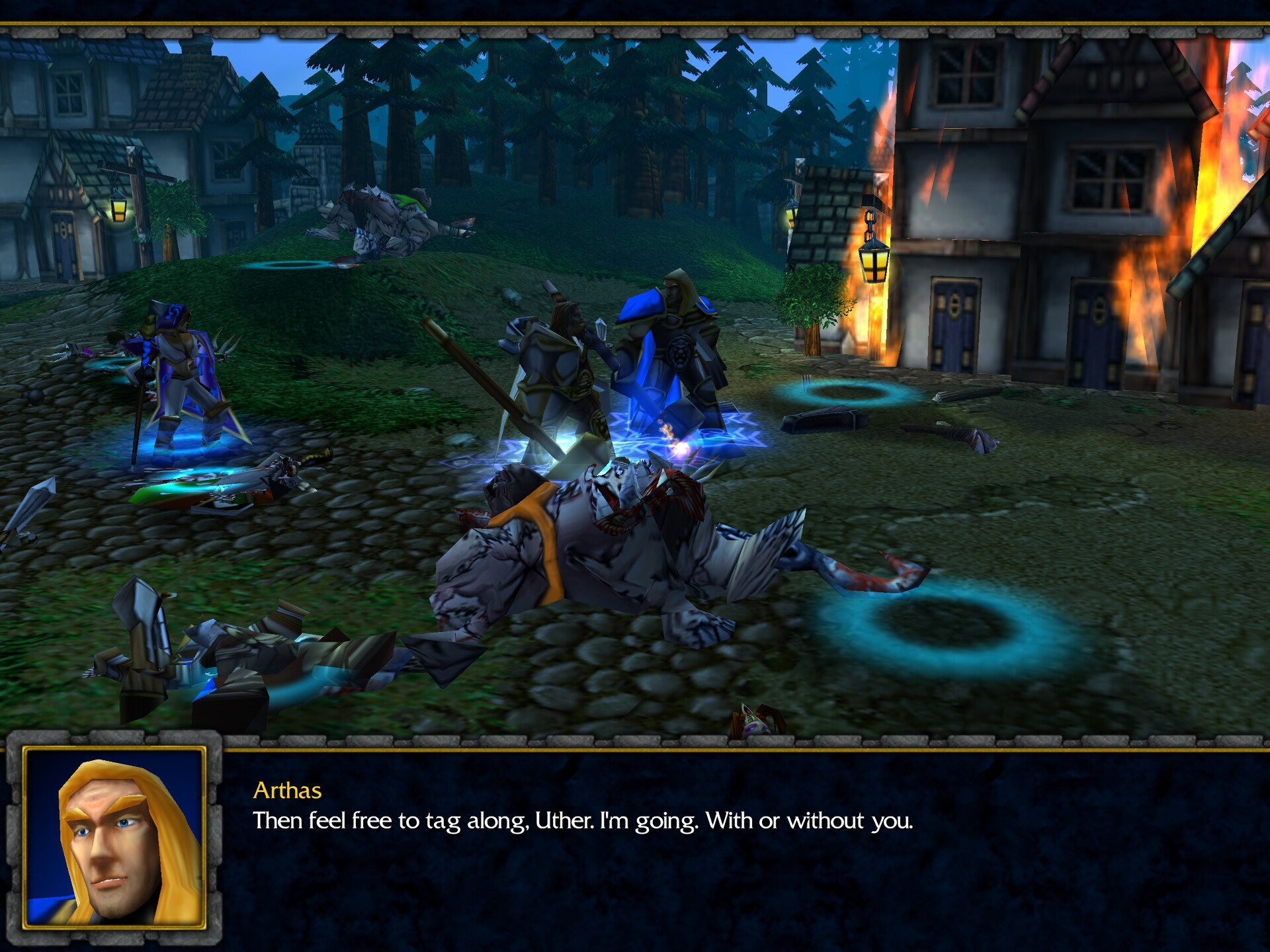
We’re beginning to see Arthas’s kindness and graciousness unravel. Part of it could be the stress of fighting undead non-stop for days, of having to organize the defense of Hearthglen by himself (if only there was a competent paladin still governing it…), but I think he’s also annoyed that he didn’t get the glory of being the savior of Hearthglen, and Uther stole what could have been his spotlight.
Arthas isn’t content with just doing what’s right. He wants to have the glory, the feeling of righteousness and meting out justice, he wants to actually be hailed as the knight in shining armor he posits himself as, and he wants the pride of presenting the head of his sworn enemy to his people. For now, his interests align with the interests of the kingdom. But what would happen should the two diverge?
We’re about to find out.
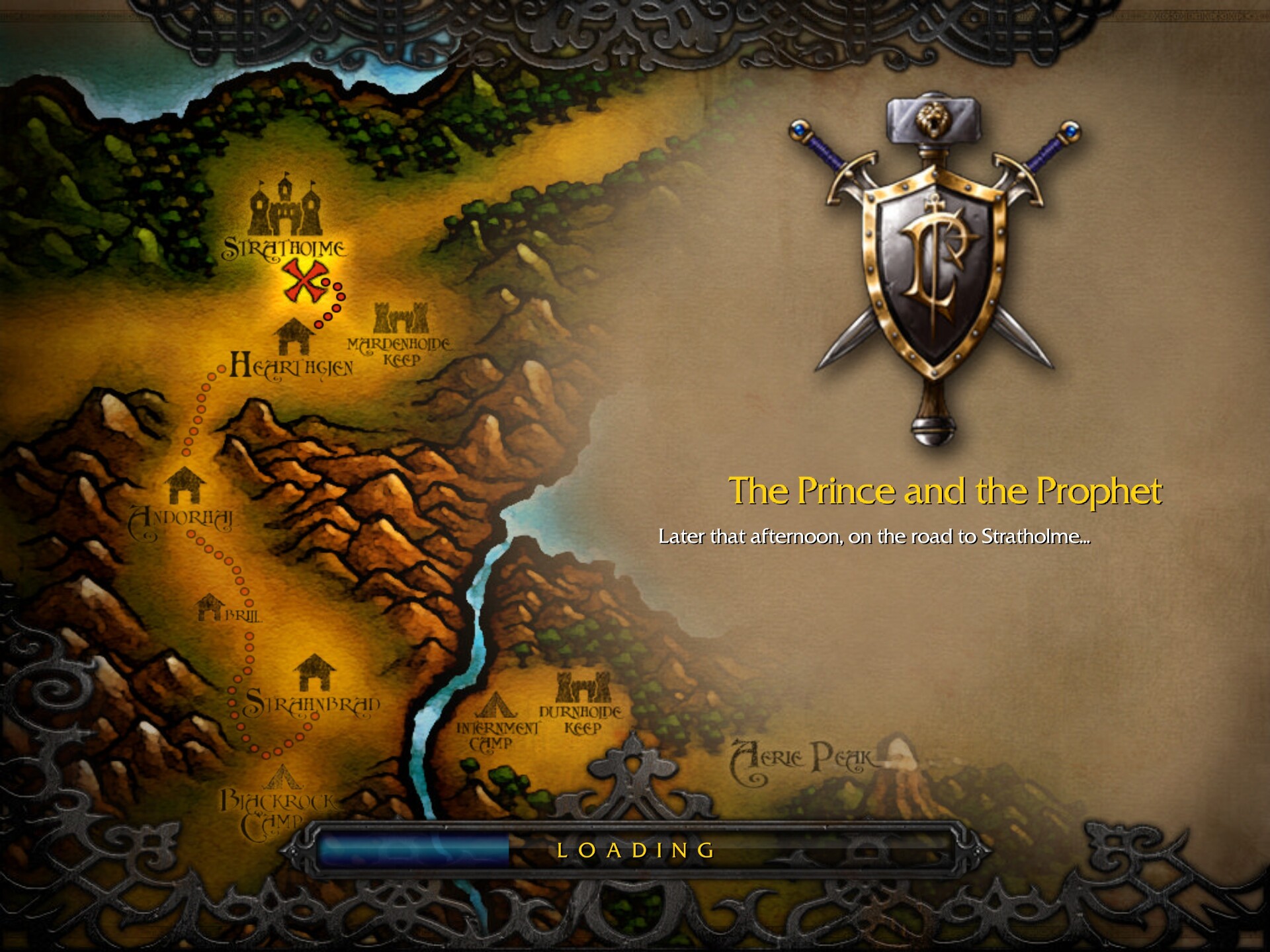
We get another interlude. The Prophet stops Arthas on the road and begins his spiel. Arthas’s reaction is predictable:
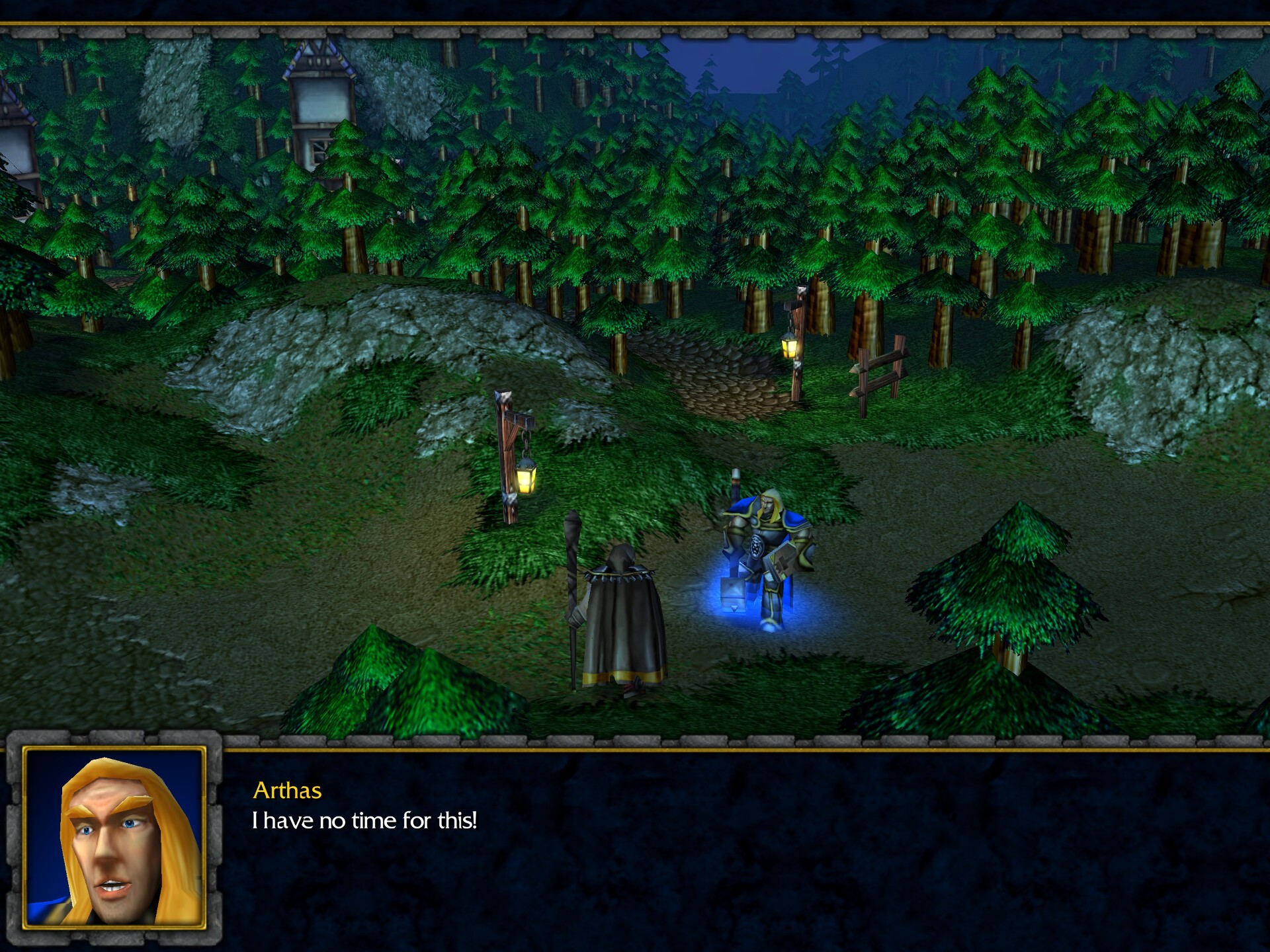
The Prophet warns him that this land is doomed, the only salvation lies west, and the harder Arthas strives to slay his enemies, the faster he’ll deliver his people into their hands. But Arthas is undeterred. Nothing will convince him to turn away from defending his people — not the Prophet…
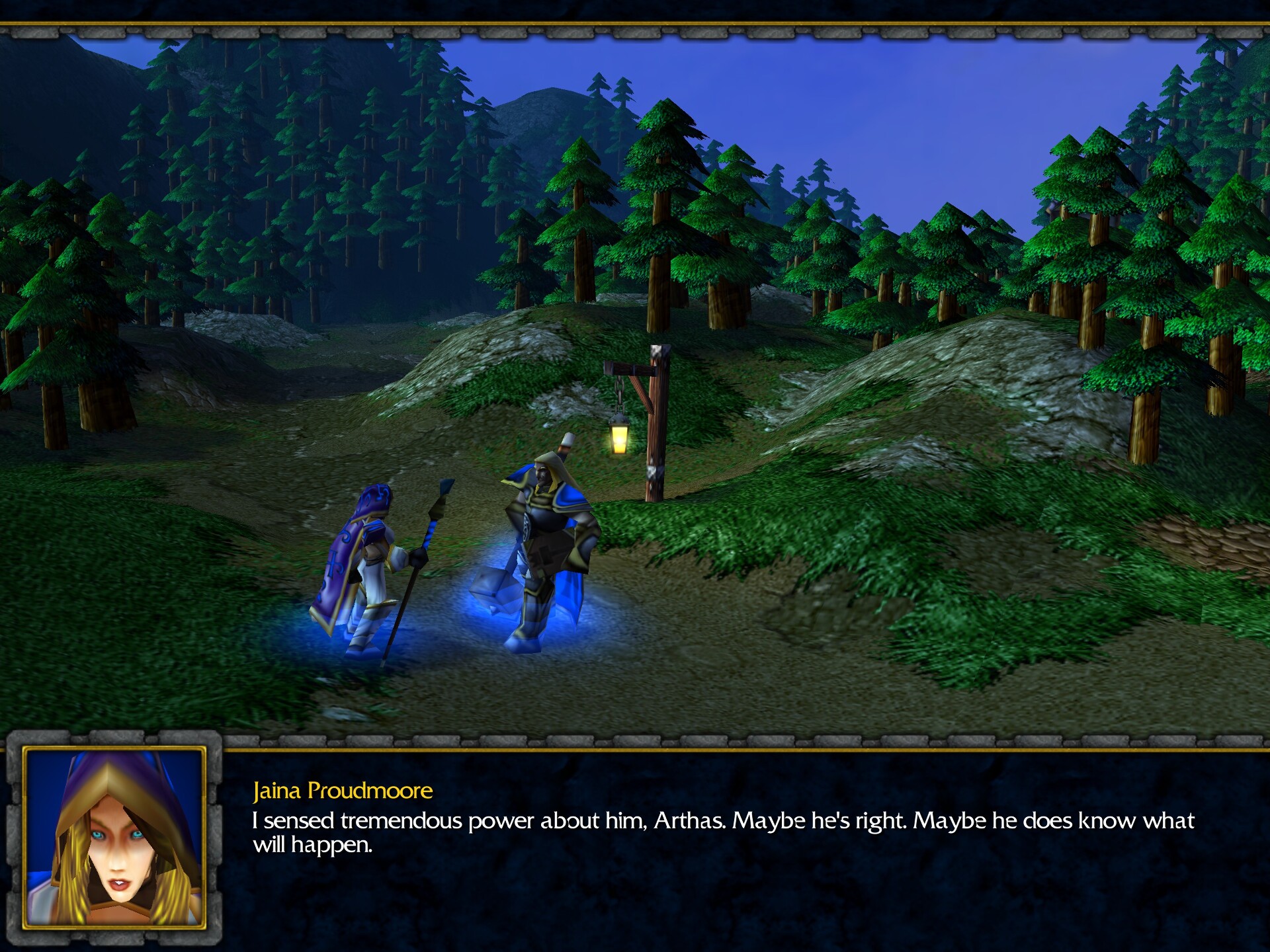
…and not Jaina. Who has been eavesdropping again. Nothing will convince Arthas to abandon his homeland, and he’ll be the champion his people deserve.
Next up: Stratholme and beyond!
-
Here’s a fun geography question: what are these places? The Prophet last spoke to Thrall, in the Arathi Highlands. The peaks could conceivably be the Alterac Mountains, but the desert really is misplaced, as there are no deserts on the northern continent. ↩
-
By the standards of video game storytelling in 2002. ↩
-
It will be a while before Blizzard starts playing this character archetype unironically. ↩
-
In Warcraft 2, he was called Uther Lightbringer, without the “the”. I don’t know if “Lightbringer” was actually supposed to be his last name back then, rather than an epithet, or it was an oversight. ↩
-
They are a mix of different European cultures, granted. We also get Benedict, Achilles and Marie Claire Antoinette, with no indication of what human nations in-universe have such naming conventions. ↩
-
For what are probably balance reasons, Jaina can only teleport and turn invisible in cutscenes, not as a playable hero in-game. ↩
Comments
Bruce Baugh
Following one (1) link as I read this post last night got me the following in my suggested YouTube viewing this morning. I think I blame you. :)
ClaudiaSilvestri
Saying that the Prophet has tremendous power seems like an odd argument that he’s right, though; isn’t it equally likely that he’s saying this as part of a scheme with some other motive? But I also just want to say that ‘Jaina’ always makes me think of the one from the old Star Wars EU first.
Leave a Comment